Learning Management System Use Cases
VerifiedAdded on 2020/03/04
|51
|8326
|41
AI Summary
This assignment delves into the human activity system for learning management at Griffith University. It examines specific use cases within this system, such as accessibility of data and information for managing learning approaches. The analysis also encompasses non-functional requirements related to reliability, performance, operability, security, compatibility, maintainability, and transferability.
Contribute Materials
Your contribution can guide someone’s learning journey. Share your
documents today.
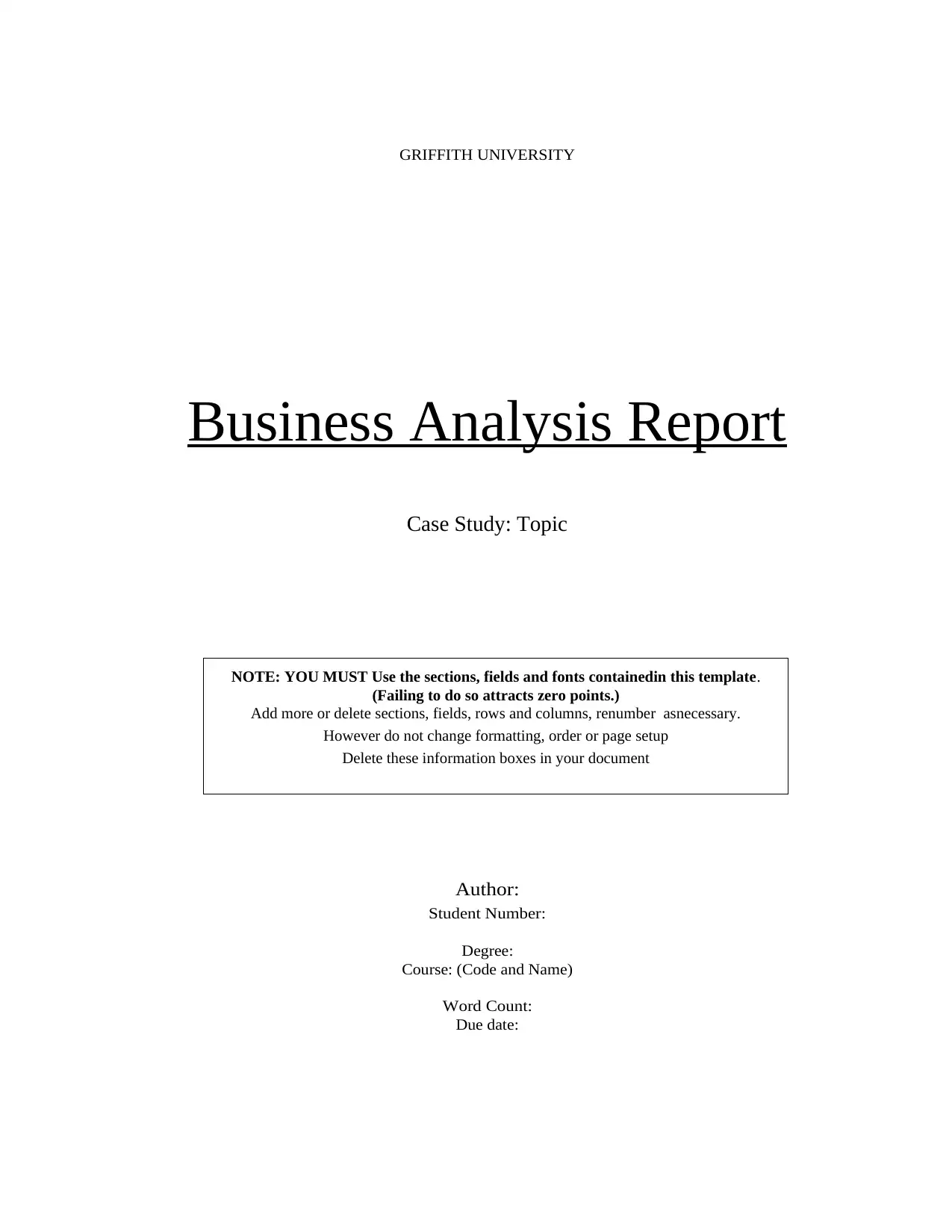
GRIFFITH UNIVERSITY
Business Analysis Report
Case Study: Topic
Author:
Student Number:
Degree:
Course: (Code and Name)
Word Count:
Due date:
NOTE: YOU MUST Use the sections, fields and fonts containedin this template.
(Failing to do so attracts zero points.)
Add more or delete sections, fields, rows and columns, renumber asnecessary.
However do not change formatting, order or page setup
Delete these information boxes in your document
Business Analysis Report
Case Study: Topic
Author:
Student Number:
Degree:
Course: (Code and Name)
Word Count:
Due date:
NOTE: YOU MUST Use the sections, fields and fonts containedin this template.
(Failing to do so attracts zero points.)
Add more or delete sections, fields, rows and columns, renumber asnecessary.
However do not change formatting, order or page setup
Delete these information boxes in your document
Secure Best Marks with AI Grader
Need help grading? Try our AI Grader for instant feedback on your assignments.
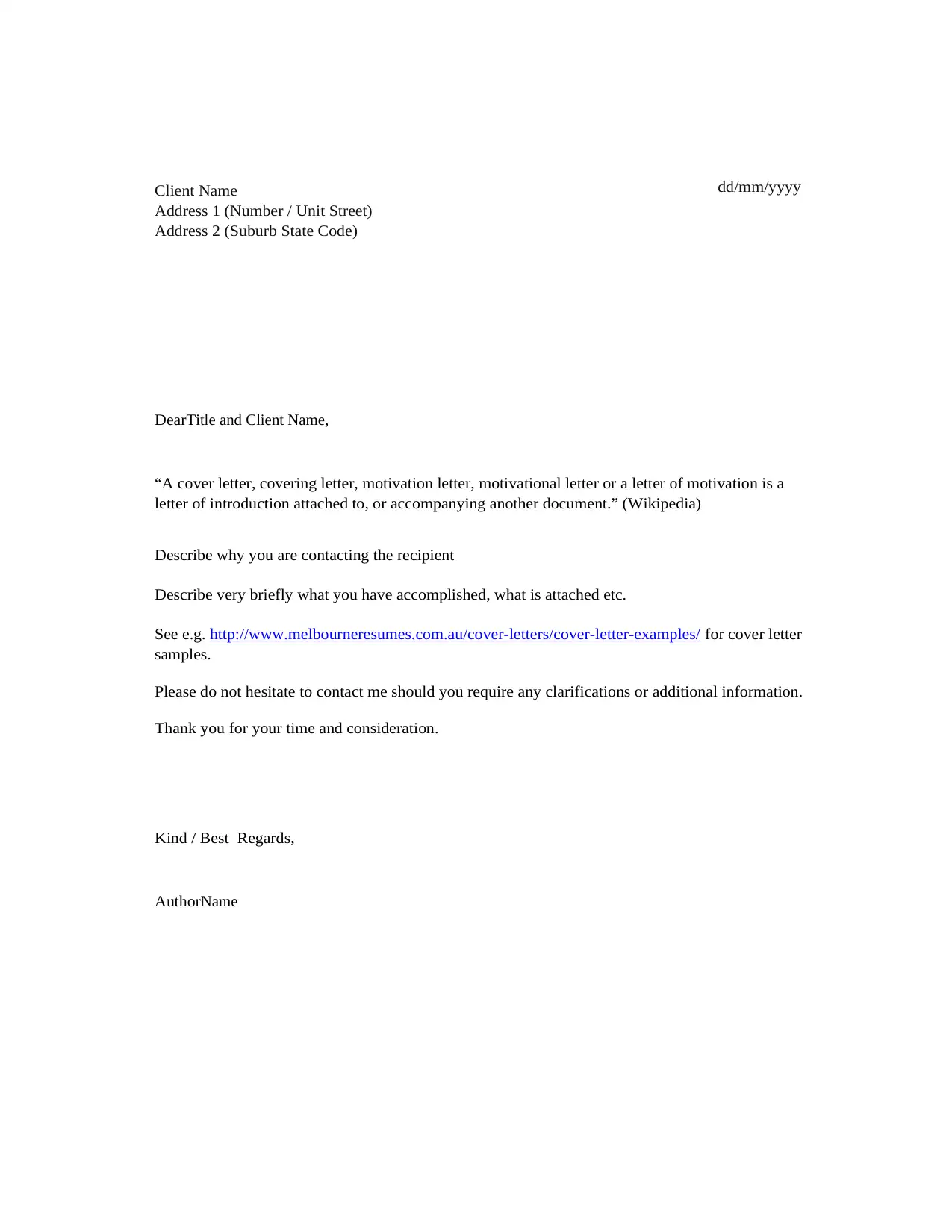
Client Name
Address 1 (Number / Unit Street)
Address 2 (Suburb State Code)
DearTitle and Client Name ,
“A cover letter, covering letter, motivation letter, motivational letter or a letter of motivation is a
letter of introduction attached to, or accompanying another document.” (Wikipedia)
Describe why you are contacting the recipient
Describe very briefly what you have accomplished, what is attached etc.
See e.g. http://www.melbourneresumes.com.au/cover-letters/cover-letter-examples/ for cover letter
samples.
Please do not hesitate to contact me should you require any clarifications or additional information.
Thank you for your time and consideration.
Kind / Best Regards,
AuthorName
dd/mm/yyyy
Address 1 (Number / Unit Street)
Address 2 (Suburb State Code)
DearTitle and Client Name ,
“A cover letter, covering letter, motivation letter, motivational letter or a letter of motivation is a
letter of introduction attached to, or accompanying another document.” (Wikipedia)
Describe why you are contacting the recipient
Describe very briefly what you have accomplished, what is attached etc.
See e.g. http://www.melbourneresumes.com.au/cover-letters/cover-letter-examples/ for cover letter
samples.
Please do not hesitate to contact me should you require any clarifications or additional information.
Thank you for your time and consideration.
Kind / Best Regards,
AuthorName
dd/mm/yyyy
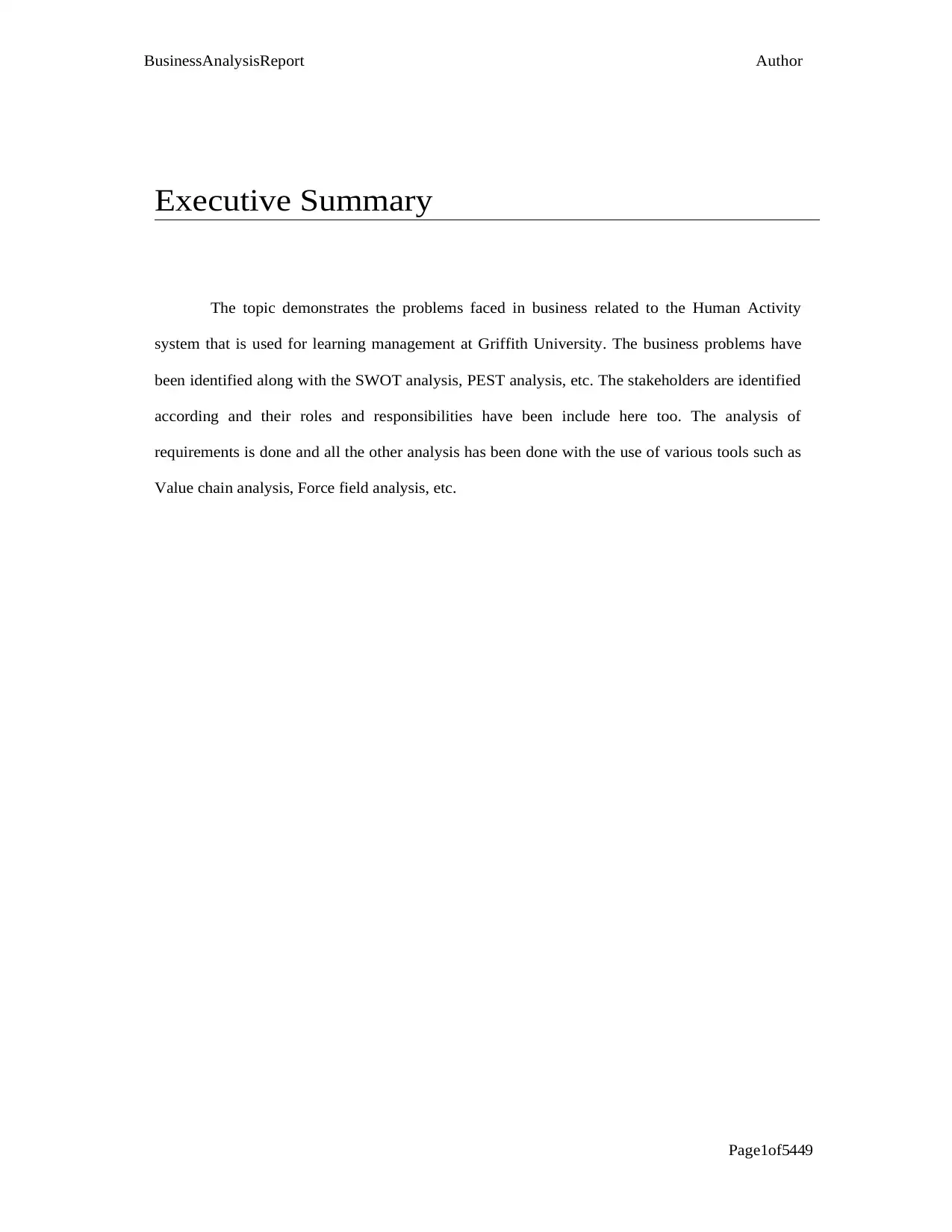
Page1of5449
BusinessAnalysisReport Author
Executive Summary
The topic demonstrates the problems faced in business related to the Human Activity
system that is used for learning management at Griffith University. The business problems have
been identified along with the SWOT analysis, PEST analysis, etc. The stakeholders are identified
according and their roles and responsibilities have been include here too. The analysis of
requirements is done and all the other analysis has been done with the use of various tools such as
Value chain analysis, Force field analysis, etc.
BusinessAnalysisReport Author
Executive Summary
The topic demonstrates the problems faced in business related to the Human Activity
system that is used for learning management at Griffith University. The business problems have
been identified along with the SWOT analysis, PEST analysis, etc. The stakeholders are identified
according and their roles and responsibilities have been include here too. The analysis of
requirements is done and all the other analysis has been done with the use of various tools such as
Value chain analysis, Force field analysis, etc.
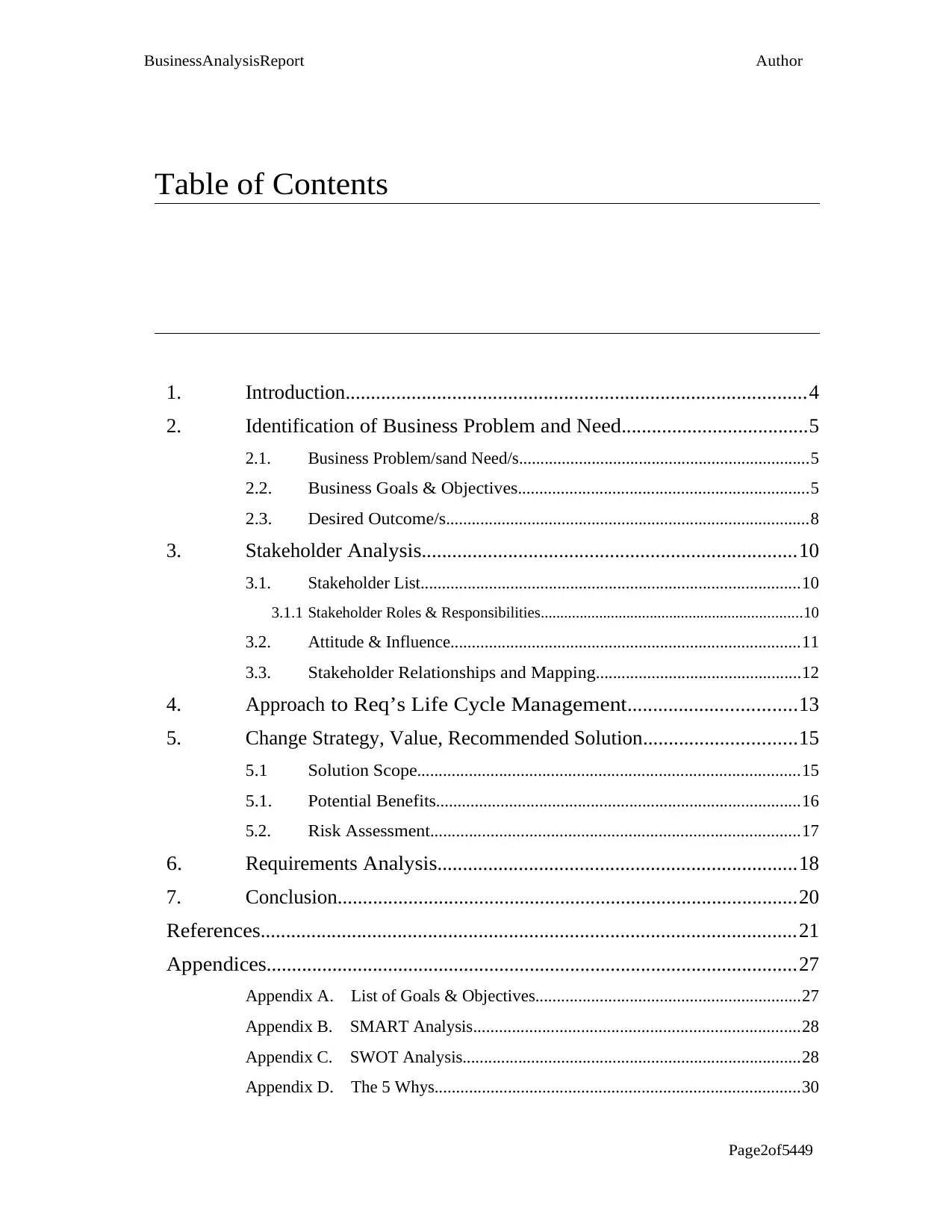
BusinessAnalysisReport Author
Page2of5449
Table of Contents
1. Introduction...........................................................................................4
2. Identification of Business Problem and Need.....................................5
2.1. Business Problem/sand Need/s....................................................................5
2.2. Business Goals & Objectives....................................................................5
2.3. Desired Outcome/s.....................................................................................8
3. Stakeholder Analysis..........................................................................10
3.1. Stakeholder List.........................................................................................10
3.1.1 Stakeholder Roles & Responsibilities...................................................................10
3.2. Attitude & Influence..................................................................................11
3.3. Stakeholder Relationships and Mapping................................................12
4. Approach to Req’s Life Cycle Management.................................13
5. Change Strategy, Value, Recommended Solution..............................15
5.1 Solution Scope.........................................................................................15
5.1. Potential Benefits.....................................................................................16
5.2. Risk Assessment......................................................................................17
6. Requirements Analysis.......................................................................18
7. Conclusion...........................................................................................20
References..........................................................................................................21
Appendices.........................................................................................................27
Appendix A. List of Goals & Objectives..............................................................27
Appendix B. SMART Analysis............................................................................28
Appendix C. SWOT Analysis...............................................................................28
Appendix D. The 5 Whys.....................................................................................30
Page2of5449
Table of Contents
1. Introduction...........................................................................................4
2. Identification of Business Problem and Need.....................................5
2.1. Business Problem/sand Need/s....................................................................5
2.2. Business Goals & Objectives....................................................................5
2.3. Desired Outcome/s.....................................................................................8
3. Stakeholder Analysis..........................................................................10
3.1. Stakeholder List.........................................................................................10
3.1.1 Stakeholder Roles & Responsibilities...................................................................10
3.2. Attitude & Influence..................................................................................11
3.3. Stakeholder Relationships and Mapping................................................12
4. Approach to Req’s Life Cycle Management.................................13
5. Change Strategy, Value, Recommended Solution..............................15
5.1 Solution Scope.........................................................................................15
5.1. Potential Benefits.....................................................................................16
5.2. Risk Assessment......................................................................................17
6. Requirements Analysis.......................................................................18
7. Conclusion...........................................................................................20
References..........................................................................................................21
Appendices.........................................................................................................27
Appendix A. List of Goals & Objectives..............................................................27
Appendix B. SMART Analysis............................................................................28
Appendix C. SWOT Analysis...............................................................................28
Appendix D. The 5 Whys.....................................................................................30
Secure Best Marks with AI Grader
Need help grading? Try our AI Grader for instant feedback on your assignments.
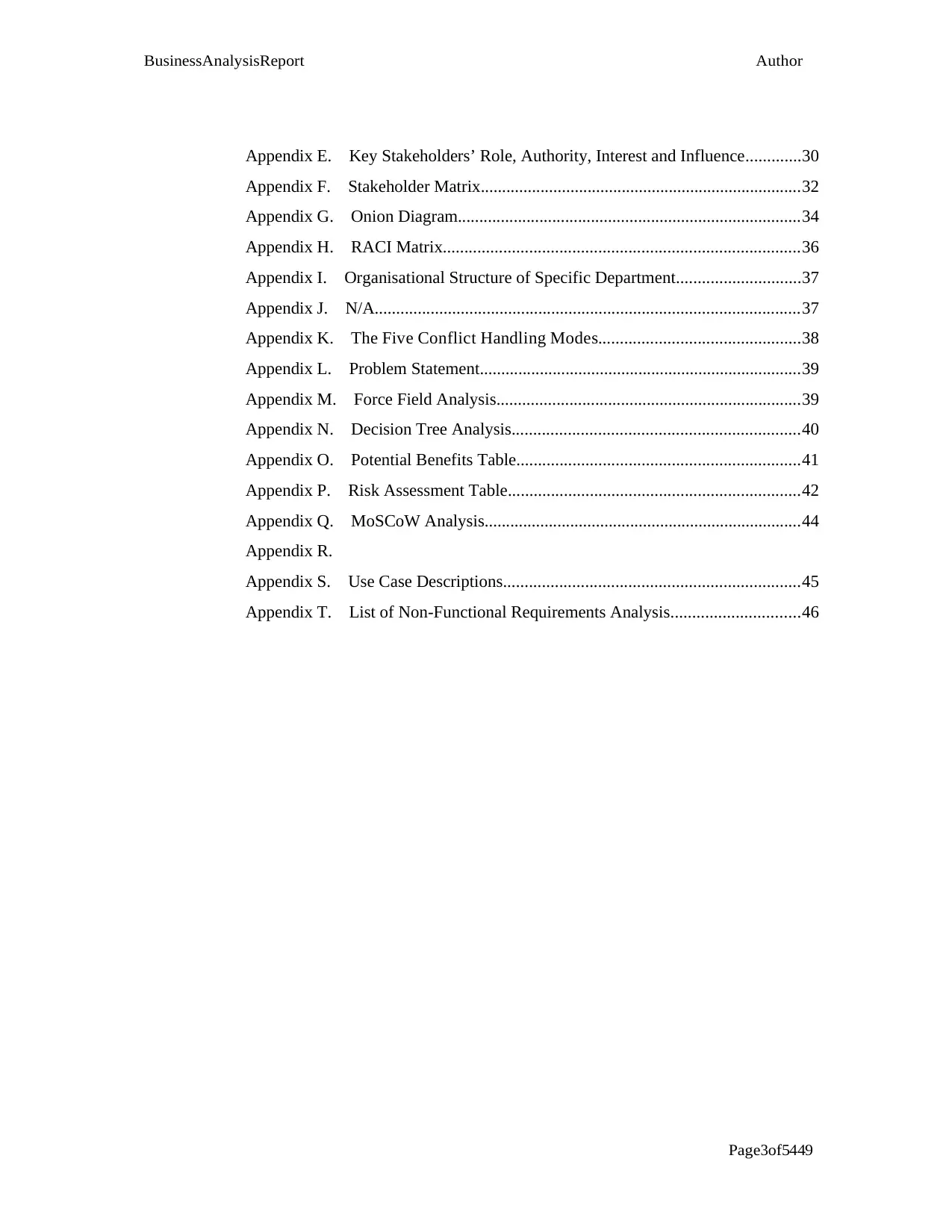
BusinessAnalysisReport Author
Page3of5449
Appendix E. Key Stakeholders’ Role, Authority, Interest and Influence.............30
Appendix F. Stakeholder Matrix...........................................................................32
Appendix G. Onion Diagram................................................................................34
Appendix H. RACI Matrix...................................................................................36
Appendix I. Organisational Structure of Specific Department.............................37
Appendix J. N/A...................................................................................................37
Appendix K. The Five Conflict Handling Modes...............................................38
Appendix L. Problem Statement...........................................................................39
Appendix M. Force Field Analysis.......................................................................39
Appendix N. Decision Tree Analysis...................................................................40
Appendix O. Potential Benefits Table..................................................................41
Appendix P. Risk Assessment Table....................................................................42
Appendix Q. MoSCoW Analysis..........................................................................44
Appendix R.
Appendix S. Use Case Descriptions.....................................................................45
Appendix T. List of Non-Functional Requirements Analysis..............................46
Page3of5449
Appendix E. Key Stakeholders’ Role, Authority, Interest and Influence.............30
Appendix F. Stakeholder Matrix...........................................................................32
Appendix G. Onion Diagram................................................................................34
Appendix H. RACI Matrix...................................................................................36
Appendix I. Organisational Structure of Specific Department.............................37
Appendix J. N/A...................................................................................................37
Appendix K. The Five Conflict Handling Modes...............................................38
Appendix L. Problem Statement...........................................................................39
Appendix M. Force Field Analysis.......................................................................39
Appendix N. Decision Tree Analysis...................................................................40
Appendix O. Potential Benefits Table..................................................................41
Appendix P. Risk Assessment Table....................................................................42
Appendix Q. MoSCoW Analysis..........................................................................44
Appendix R.
Appendix S. Use Case Descriptions.....................................................................45
Appendix T. List of Non-Functional Requirements Analysis..............................46
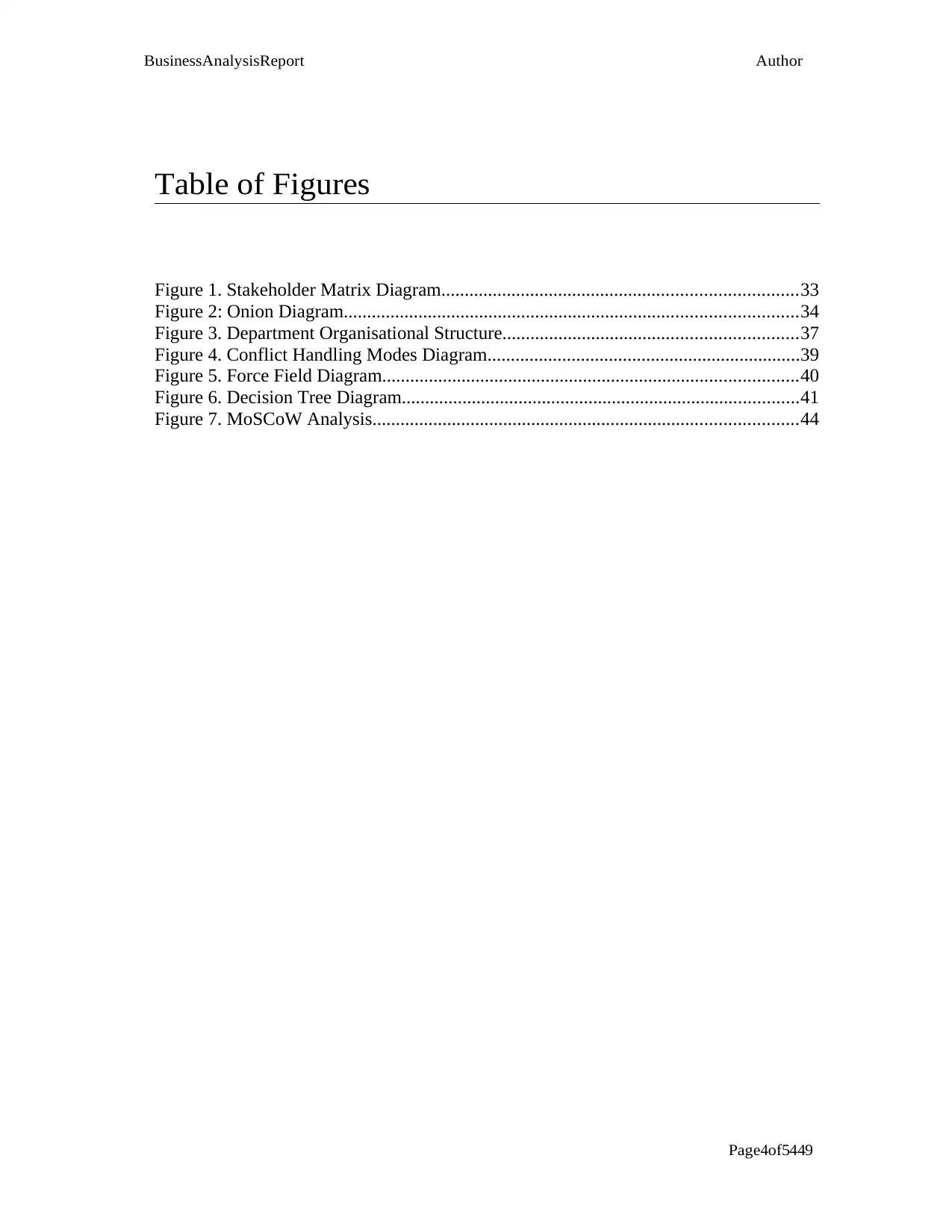
BusinessAnalysisReport Author
Page4of5449
Table of Figures
Figure 1. Stakeholder Matrix Diagram............................................................................33
Figure 2: Onion Diagram.................................................................................................34
Figure 3. Department Organisational Structure...............................................................37
Figure 4. Conflict Handling Modes Diagram...................................................................39
Figure 5. Force Field Diagram.........................................................................................40
Figure 6. Decision Tree Diagram.....................................................................................41
Figure 7. MoSCoW Analysis...........................................................................................44
Page4of5449
Table of Figures
Figure 1. Stakeholder Matrix Diagram............................................................................33
Figure 2: Onion Diagram.................................................................................................34
Figure 3. Department Organisational Structure...............................................................37
Figure 4. Conflict Handling Modes Diagram...................................................................39
Figure 5. Force Field Diagram.........................................................................................40
Figure 6. Decision Tree Diagram.....................................................................................41
Figure 7. MoSCoW Analysis...........................................................................................44
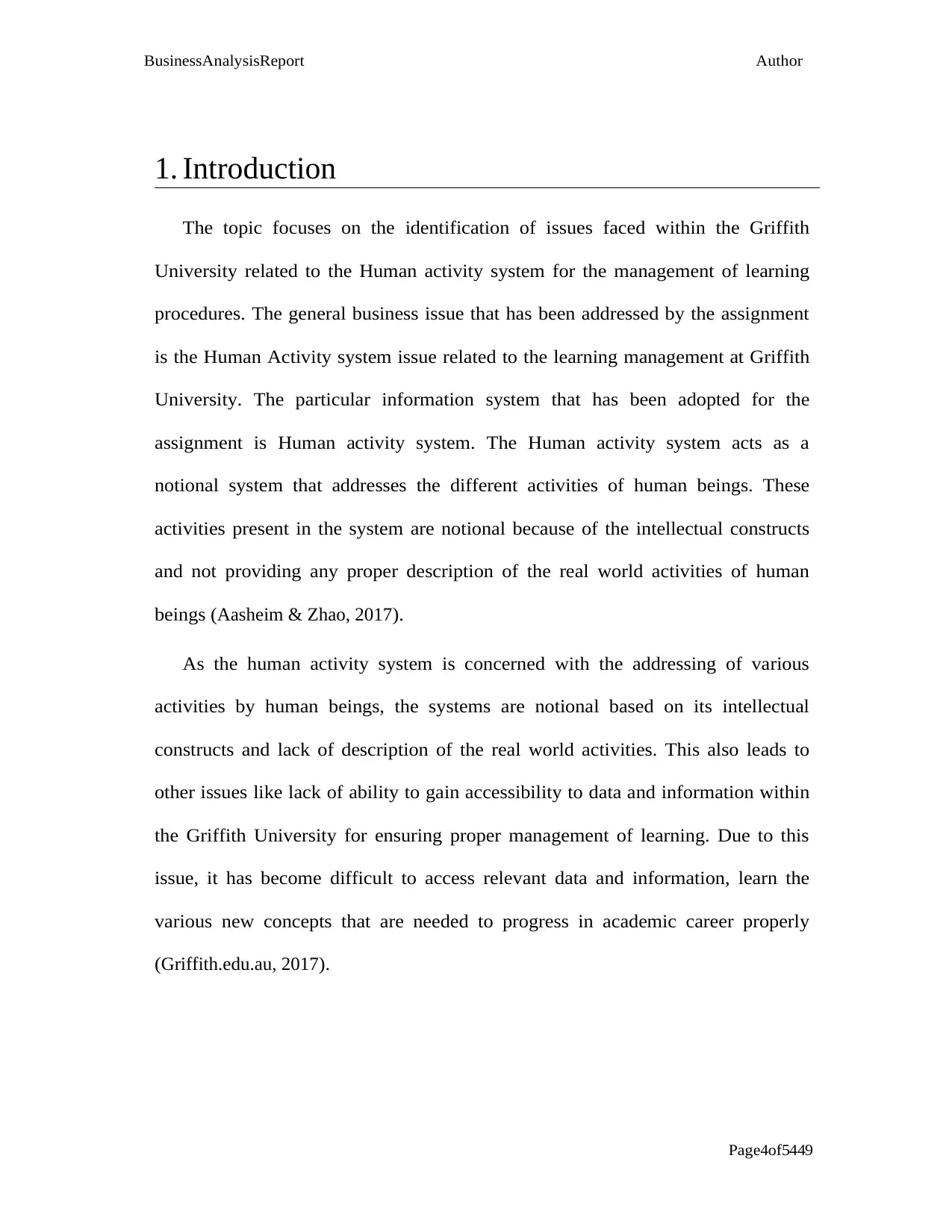
BusinessAnalysisReport Author
Page4of5449
1. Introduction
The topic focuses on the identification of issues faced within the Griffith
University related to the Human activity system for the management of learning
procedures. The general business issue that has been addressed by the assignment
is the Human Activity system issue related to the learning management at Griffith
University. The particular information system that has been adopted for the
assignment is Human activity system. The Human activity system acts as a
notional system that addresses the different activities of human beings. These
activities present in the system are notional because of the intellectual constructs
and not providing any proper description of the real world activities of human
beings (Aasheim & Zhao, 2017 ).
As the human activity system is concerned with the addressing of various
activities by human beings, the systems are notional based on its intellectual
constructs and lack of description of the real world activities. This also leads to
other issues like lack of ability to gain accessibility to data and information within
the Griffith University for ensuring proper management of learning. Due to this
issue, it has become difficult to access relevant data and information, learn the
various new concepts that are needed to progress in academic career properly
(Griffith.edu.au, 2017 ).
Page4of5449
1. Introduction
The topic focuses on the identification of issues faced within the Griffith
University related to the Human activity system for the management of learning
procedures. The general business issue that has been addressed by the assignment
is the Human Activity system issue related to the learning management at Griffith
University. The particular information system that has been adopted for the
assignment is Human activity system. The Human activity system acts as a
notional system that addresses the different activities of human beings. These
activities present in the system are notional because of the intellectual constructs
and not providing any proper description of the real world activities of human
beings (Aasheim & Zhao, 2017 ).
As the human activity system is concerned with the addressing of various
activities by human beings, the systems are notional based on its intellectual
constructs and lack of description of the real world activities. This also leads to
other issues like lack of ability to gain accessibility to data and information within
the Griffith University for ensuring proper management of learning. Due to this
issue, it has become difficult to access relevant data and information, learn the
various new concepts that are needed to progress in academic career properly
(Griffith.edu.au, 2017 ).
Paraphrase This Document
Need a fresh take? Get an instant paraphrase of this document with our AI Paraphraser
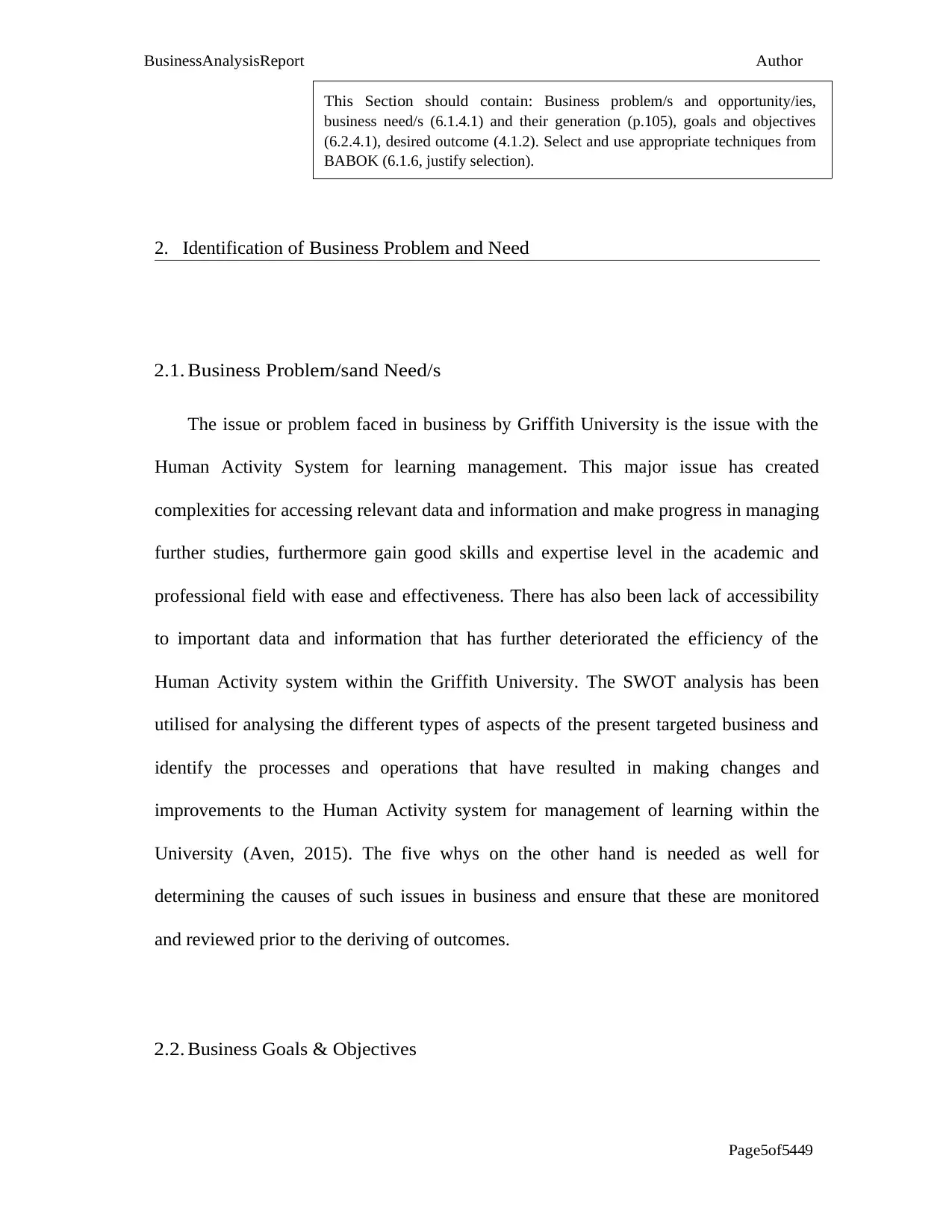
BusinessAnalysisReport Author
Page5of5449
2. Identification of Business Problem and Need
2.1. Business Problem/sand Need/s
The issue or problem faced in business by Griffith University is the issue with the
Human Activity System for learning management. This major issue has created
complexities for accessing relevant data and information and make progress in managing
further studies, furthermore gain good skills and expertise level in the academic and
professional field with ease and effectiveness. There has also been lack of accessibility
to important data and information that has further deteriorated the efficiency of the
Human Activity system within the Griffith University. The SWOT analysis has been
utilised for analysing the different types of aspects of the present targeted business and
identify the processes and operations that have resulted in making changes and
improvements to the Human Activity system for management of learning within the
University (Aven, 2015). The five whys on the other hand is needed as well for
determining the causes of such issues in business and ensure that these are monitored
and reviewed prior to the deriving of outcomes.
2.2. Business Goals & Objectives
This Section should contain: Business problem/s and opportunity/ies,
business need/s (6.1.4.1) and their generation (p.105), goals and objectives
(6.2.4.1), desired outcome (4.1.2). Select and use appropriate techniques from
BABOK (6.1.6, justify selection).
Page5of5449
2. Identification of Business Problem and Need
2.1. Business Problem/sand Need/s
The issue or problem faced in business by Griffith University is the issue with the
Human Activity System for learning management. This major issue has created
complexities for accessing relevant data and information and make progress in managing
further studies, furthermore gain good skills and expertise level in the academic and
professional field with ease and effectiveness. There has also been lack of accessibility
to important data and information that has further deteriorated the efficiency of the
Human Activity system within the Griffith University. The SWOT analysis has been
utilised for analysing the different types of aspects of the present targeted business and
identify the processes and operations that have resulted in making changes and
improvements to the Human Activity system for management of learning within the
University (Aven, 2015). The five whys on the other hand is needed as well for
determining the causes of such issues in business and ensure that these are monitored
and reviewed prior to the deriving of outcomes.
2.2. Business Goals & Objectives
This Section should contain: Business problem/s and opportunity/ies,
business need/s (6.1.4.1) and their generation (p.105), goals and objectives
(6.2.4.1), desired outcome (4.1.2). Select and use appropriate techniques from
BABOK (6.1.6, justify selection).
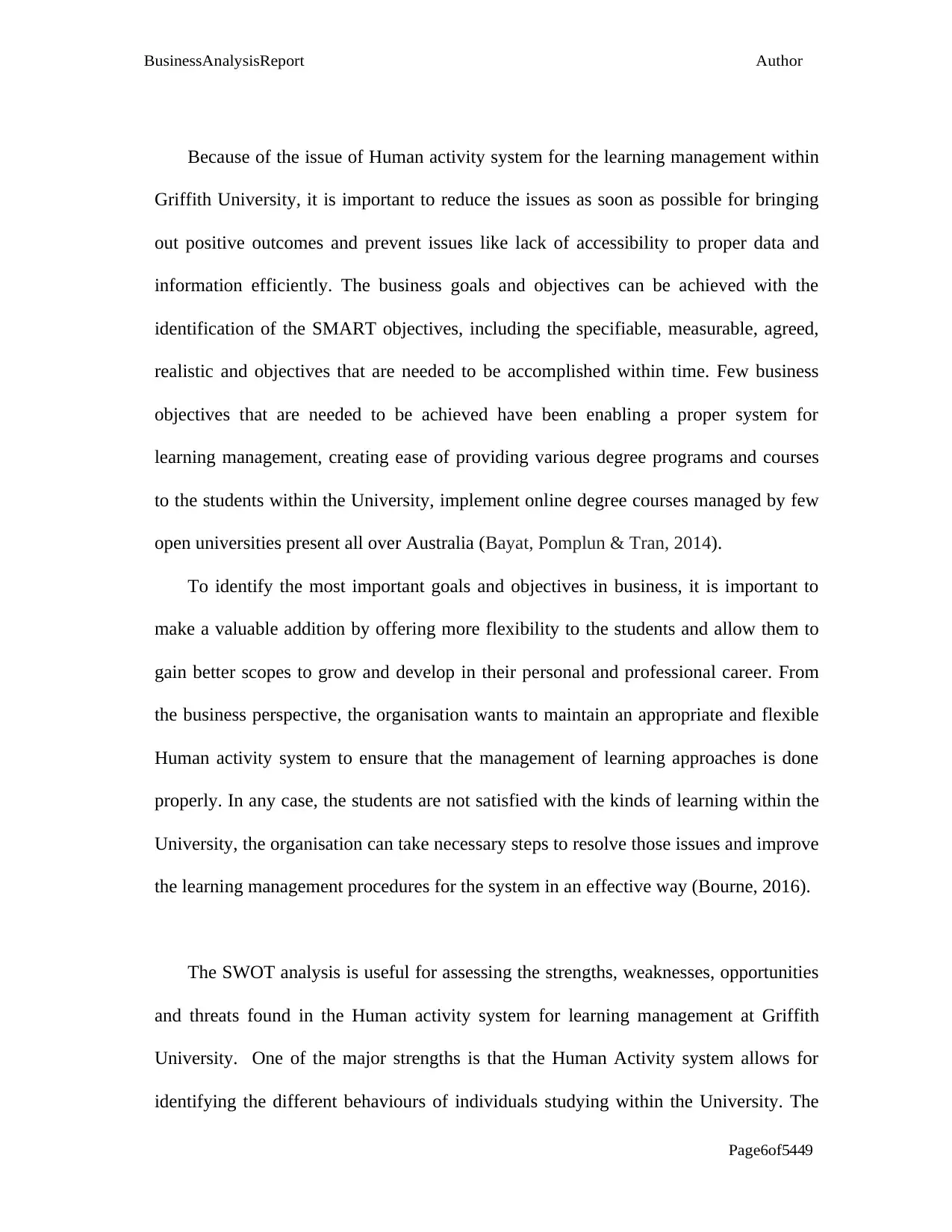
BusinessAnalysisReport Author
Page6of5449
Because of the issue of Human activity system for the learning management within
Griffith University, it is important to reduce the issues as soon as possible for bringing
out positive outcomes and prevent issues like lack of accessibility to proper data and
information efficiently. The business goals and objectives can be achieved with the
identification of the SMART objectives, including the specifiable, measurable, agreed,
realistic and objectives that are needed to be accomplished within time. Few business
objectives that are needed to be achieved have been enabling a proper system for
learning management, creating ease of providing various degree programs and courses
to the students within the University, implement online degree courses managed by few
open universities present all over Australia (Bayat, Pomplun & Tran, 2014).
To identify the most important goals and objectives in business, it is important to
make a valuable addition by offering more flexibility to the students and allow them to
gain better scopes to grow and develop in their personal and professional career. From
the business perspective, the organisation wants to maintain an appropriate and flexible
Human activity system to ensure that the management of learning approaches is done
properly. In any case, the students are not satisfied with the kinds of learning within the
University, the organisation can take necessary steps to resolve those issues and improve
the learning management procedures for the system in an effective way (Bourne, 2016).
The SWOT analysis is useful for assessing the strengths, weaknesses, opportunities
and threats found in the Human activity system for learning management at Griffith
University. One of the major strengths is that the Human Activity system allows for
identifying the different behaviours of individuals studying within the University. The
Page6of5449
Because of the issue of Human activity system for the learning management within
Griffith University, it is important to reduce the issues as soon as possible for bringing
out positive outcomes and prevent issues like lack of accessibility to proper data and
information efficiently. The business goals and objectives can be achieved with the
identification of the SMART objectives, including the specifiable, measurable, agreed,
realistic and objectives that are needed to be accomplished within time. Few business
objectives that are needed to be achieved have been enabling a proper system for
learning management, creating ease of providing various degree programs and courses
to the students within the University, implement online degree courses managed by few
open universities present all over Australia (Bayat, Pomplun & Tran, 2014).
To identify the most important goals and objectives in business, it is important to
make a valuable addition by offering more flexibility to the students and allow them to
gain better scopes to grow and develop in their personal and professional career. From
the business perspective, the organisation wants to maintain an appropriate and flexible
Human activity system to ensure that the management of learning approaches is done
properly. In any case, the students are not satisfied with the kinds of learning within the
University, the organisation can take necessary steps to resolve those issues and improve
the learning management procedures for the system in an effective way (Bourne, 2016).
The SWOT analysis is useful for assessing the strengths, weaknesses, opportunities
and threats found in the Human activity system for learning management at Griffith
University. One of the major strengths is that the Human Activity system allows for
identifying the different behaviours of individuals studying within the University. The
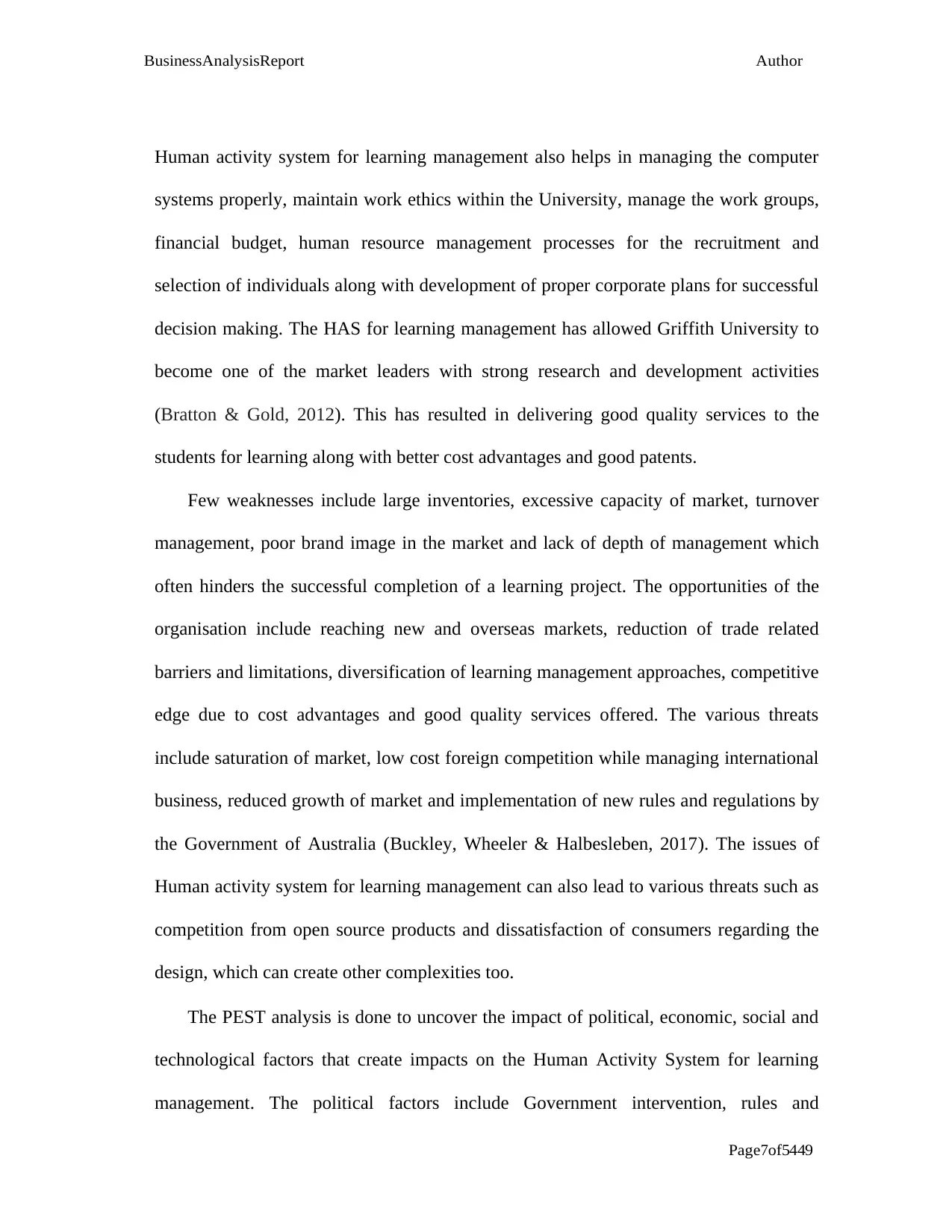
BusinessAnalysisReport Author
Page7of5449
Human activity system for learning management also helps in managing the computer
systems properly, maintain work ethics within the University, manage the work groups,
financial budget, human resource management processes for the recruitment and
selection of individuals along with development of proper corporate plans for successful
decision making. The HAS for learning management has allowed Griffith University to
become one of the market leaders with strong research and development activities
(Bratton & Gold, 2012). This has resulted in delivering good quality services to the
students for learning along with better cost advantages and good patents.
Few weaknesses include large inventories, excessive capacity of market, turnover
management, poor brand image in the market and lack of depth of management which
often hinders the successful completion of a learning project. The opportunities of the
organisation include reaching new and overseas markets, reduction of trade related
barriers and limitations, diversification of learning management approaches, competitive
edge due to cost advantages and good quality services offered. The various threats
include saturation of market, low cost foreign competition while managing international
business, reduced growth of market and implementation of new rules and regulations by
the Government of Australia (Buckley, Wheeler & Halbesleben, 2017). The issues of
Human activity system for learning management can also lead to various threats such as
competition from open source products and dissatisfaction of consumers regarding the
design, which can create other complexities too.
The PEST analysis is done to uncover the impact of political, economic, social and
technological factors that create impacts on the Human Activity System for learning
management. The political factors include Government intervention, rules and
Page7of5449
Human activity system for learning management also helps in managing the computer
systems properly, maintain work ethics within the University, manage the work groups,
financial budget, human resource management processes for the recruitment and
selection of individuals along with development of proper corporate plans for successful
decision making. The HAS for learning management has allowed Griffith University to
become one of the market leaders with strong research and development activities
(Bratton & Gold, 2012). This has resulted in delivering good quality services to the
students for learning along with better cost advantages and good patents.
Few weaknesses include large inventories, excessive capacity of market, turnover
management, poor brand image in the market and lack of depth of management which
often hinders the successful completion of a learning project. The opportunities of the
organisation include reaching new and overseas markets, reduction of trade related
barriers and limitations, diversification of learning management approaches, competitive
edge due to cost advantages and good quality services offered. The various threats
include saturation of market, low cost foreign competition while managing international
business, reduced growth of market and implementation of new rules and regulations by
the Government of Australia (Buckley, Wheeler & Halbesleben, 2017). The issues of
Human activity system for learning management can also lead to various threats such as
competition from open source products and dissatisfaction of consumers regarding the
design, which can create other complexities too.
The PEST analysis is done to uncover the impact of political, economic, social and
technological factors that create impacts on the Human Activity System for learning
management. The political factors include Government intervention, rules and
Secure Best Marks with AI Grader
Need help grading? Try our AI Grader for instant feedback on your assignments.
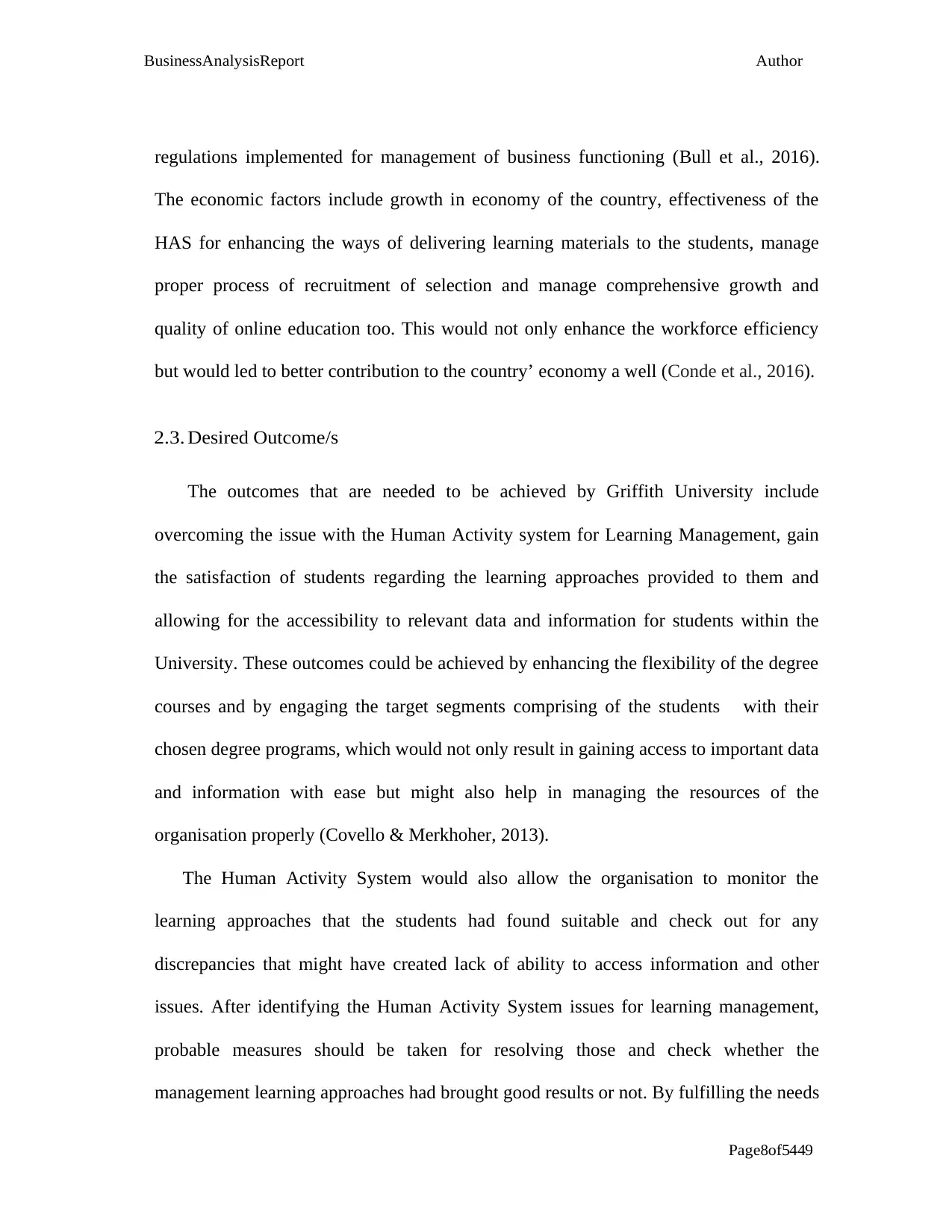
BusinessAnalysisReport Author
Page8of5449
regulations implemented for management of business functioning (Bull et al., 2016).
The economic factors include growth in economy of the country, effectiveness of the
HAS for enhancing the ways of delivering learning materials to the students, manage
proper process of recruitment of selection and manage comprehensive growth and
quality of online education too. This would not only enhance the workforce efficiency
but would led to better contribution to the country’ economy a well (Conde et al., 2016).
2.3. Desired Outcome/s
The outcomes that are needed to be achieved by Griffith University include
overcoming the issue with the Human Activity system for Learning Management, gain
the satisfaction of students regarding the learning approaches provided to them and
allowing for the accessibility to relevant data and information for students within the
University. These outcomes could be achieved by enhancing the flexibility of the degree
courses and by engaging the target segments comprising of the students with their
chosen degree programs, which would not only result in gaining access to important data
and information with ease but might also help in managing the resources of the
organisation properly (Covello & Merkhoher, 2013).
The Human Activity System would also allow the organisation to monitor the
learning approaches that the students had found suitable and check out for any
discrepancies that might have created lack of ability to access information and other
issues. After identifying the Human Activity System issues for learning management,
probable measures should be taken for resolving those and check whether the
management learning approaches had brought good results or not. By fulfilling the needs
Page8of5449
regulations implemented for management of business functioning (Bull et al., 2016).
The economic factors include growth in economy of the country, effectiveness of the
HAS for enhancing the ways of delivering learning materials to the students, manage
proper process of recruitment of selection and manage comprehensive growth and
quality of online education too. This would not only enhance the workforce efficiency
but would led to better contribution to the country’ economy a well (Conde et al., 2016).
2.3. Desired Outcome/s
The outcomes that are needed to be achieved by Griffith University include
overcoming the issue with the Human Activity system for Learning Management, gain
the satisfaction of students regarding the learning approaches provided to them and
allowing for the accessibility to relevant data and information for students within the
University. These outcomes could be achieved by enhancing the flexibility of the degree
courses and by engaging the target segments comprising of the students with their
chosen degree programs, which would not only result in gaining access to important data
and information with ease but might also help in managing the resources of the
organisation properly (Covello & Merkhoher, 2013).
The Human Activity System would also allow the organisation to monitor the
learning approaches that the students had found suitable and check out for any
discrepancies that might have created lack of ability to access information and other
issues. After identifying the Human Activity System issues for learning management,
probable measures should be taken for resolving those and check whether the
management learning approaches had brought good results or not. By fulfilling the needs

BusinessAnalysisReport Author
Page9of5449
and requirements of students, the business outcomes would tend to be more positive and
flexible such as ease and convenience of attracting more students and even provide
flexible time shifts for the learning of their degree courses within the University
( Department of Education and Training, 2011). The business would be able to focus
more on the outcomes of generating more sales, revenue and enhanced profit level in
business as well.
Page9of5449
and requirements of students, the business outcomes would tend to be more positive and
flexible such as ease and convenience of attracting more students and even provide
flexible time shifts for the learning of their degree courses within the University
( Department of Education and Training, 2011). The business would be able to focus
more on the outcomes of generating more sales, revenue and enhanced profit level in
business as well.
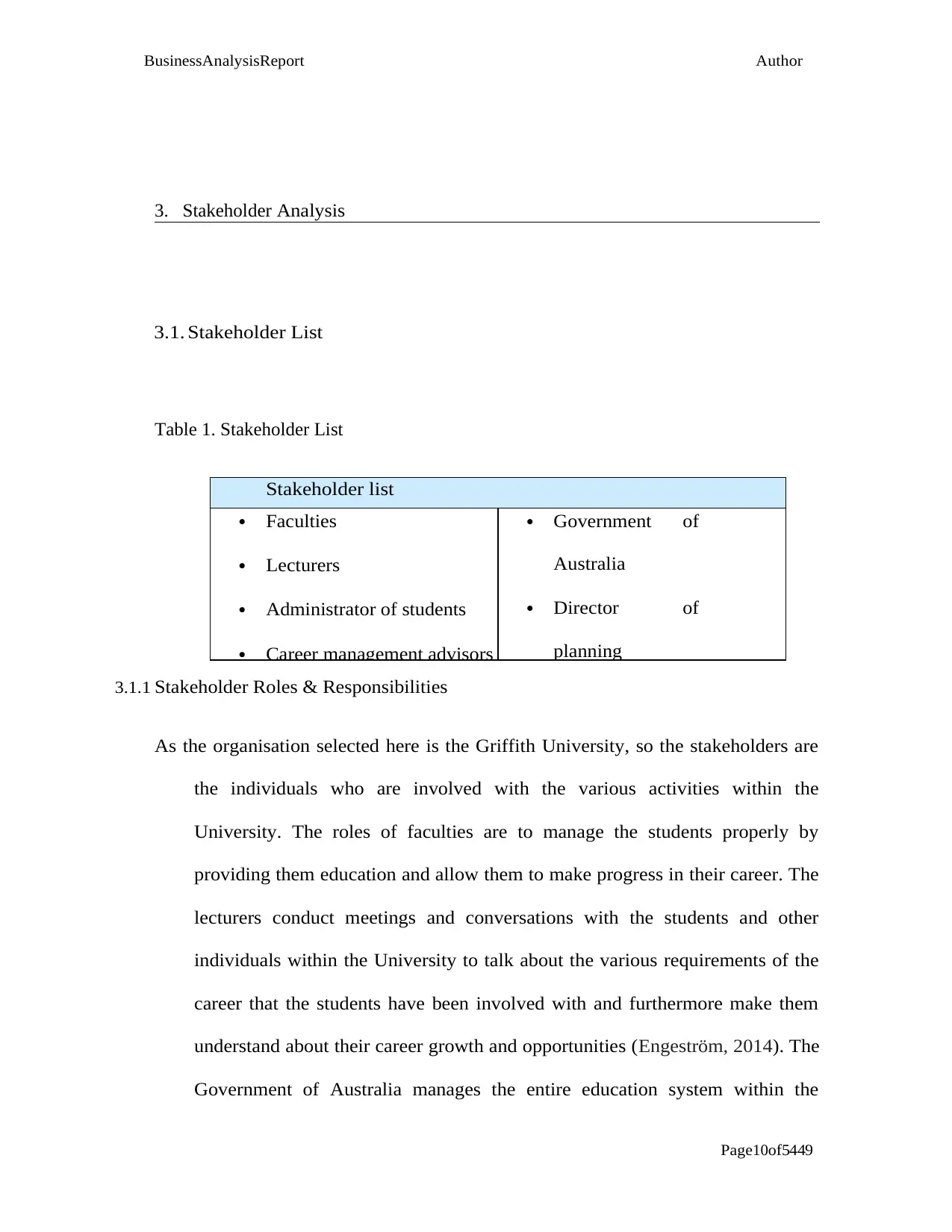
BusinessAnalysisReport Author
Page10of5449
3. Stakeholder Analysis
3.1. Stakeholder List
Table 1. Stakeholder List
Stakeholder list
Faculties
Lecturers
Administrator of students
Career management advisors
Government of
Australia
Director of
planning
3.1.1 Stakeholder Roles & Responsibilities
As the organisation selected here is the Griffith University, so the stakeholders are
the individuals who are involved with the various activities within the
University. The roles of faculties are to manage the students properly by
providing them education and allow them to make progress in their career. The
lecturers conduct meetings and conversations with the students and other
individuals within the University to talk about the various requirements of the
career that the students have been involved with and furthermore make them
understand about their career growth and opportunities (Engeström, 2014). The
Government of Australia manages the entire education system within the
Page10of5449
3. Stakeholder Analysis
3.1. Stakeholder List
Table 1. Stakeholder List
Stakeholder list
Faculties
Lecturers
Administrator of students
Career management advisors
Government of
Australia
Director of
planning
3.1.1 Stakeholder Roles & Responsibilities
As the organisation selected here is the Griffith University, so the stakeholders are
the individuals who are involved with the various activities within the
University. The roles of faculties are to manage the students properly by
providing them education and allow them to make progress in their career. The
lecturers conduct meetings and conversations with the students and other
individuals within the University to talk about the various requirements of the
career that the students have been involved with and furthermore make them
understand about their career growth and opportunities (Engeström, 2014). The
Government of Australia manages the entire education system within the
Paraphrase This Document
Need a fresh take? Get an instant paraphrase of this document with our AI Paraphraser
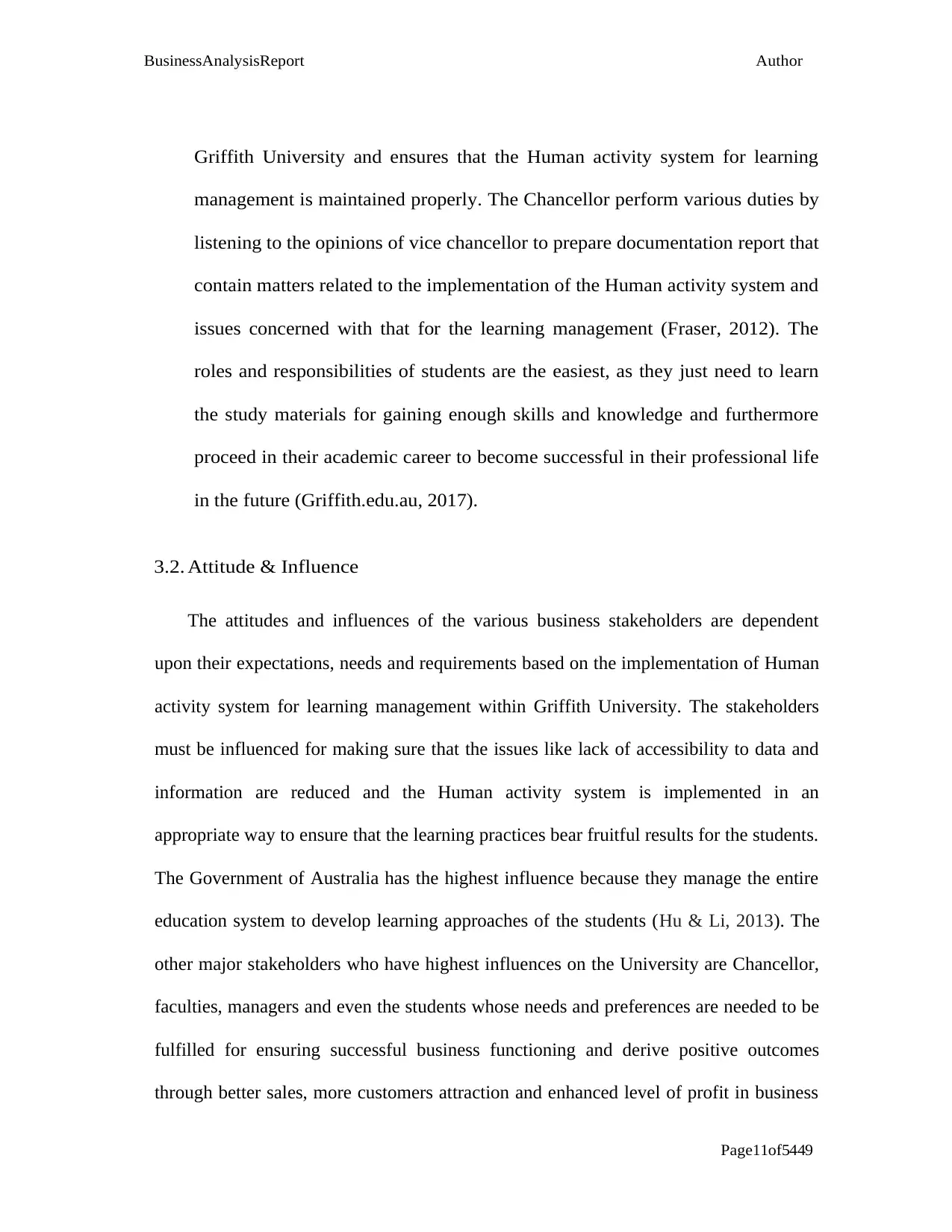
BusinessAnalysisReport Author
Page11of5449
Griffith University and ensures that the Human activity system for learning
management is maintained properly. The Chancellor perform various duties by
listening to the opinions of vice chancellor to prepare documentation report that
contain matters related to the implementation of the Human activity system and
issues concerned with that for the learning management (Fraser, 2012). The
roles and responsibilities of students are the easiest, as they just need to learn
the study materials for gaining enough skills and knowledge and furthermore
proceed in their academic career to become successful in their professional life
in the future (Griffith.edu.au, 2017).
3.2. Attitude & Influence
The attitudes and influences of the various business stakeholders are dependent
upon their expectations, needs and requirements based on the implementation of Human
activity system for learning management within Griffith University. The stakeholders
must be influenced for making sure that the issues like lack of accessibility to data and
information are reduced and the Human activity system is implemented in an
appropriate way to ensure that the learning practices bear fruitful results for the students.
The Government of Australia has the highest influence because they manage the entire
education system to develop learning approaches of the students (Hu & Li, 2013). The
other major stakeholders who have highest influences on the University are Chancellor,
faculties, managers and even the students whose needs and preferences are needed to be
fulfilled for ensuring successful business functioning and derive positive outcomes
through better sales, more customers attraction and enhanced level of profit in business
Page11of5449
Griffith University and ensures that the Human activity system for learning
management is maintained properly. The Chancellor perform various duties by
listening to the opinions of vice chancellor to prepare documentation report that
contain matters related to the implementation of the Human activity system and
issues concerned with that for the learning management (Fraser, 2012). The
roles and responsibilities of students are the easiest, as they just need to learn
the study materials for gaining enough skills and knowledge and furthermore
proceed in their academic career to become successful in their professional life
in the future (Griffith.edu.au, 2017).
3.2. Attitude & Influence
The attitudes and influences of the various business stakeholders are dependent
upon their expectations, needs and requirements based on the implementation of Human
activity system for learning management within Griffith University. The stakeholders
must be influenced for making sure that the issues like lack of accessibility to data and
information are reduced and the Human activity system is implemented in an
appropriate way to ensure that the learning practices bear fruitful results for the students.
The Government of Australia has the highest influence because they manage the entire
education system to develop learning approaches of the students (Hu & Li, 2013). The
other major stakeholders who have highest influences on the University are Chancellor,
faculties, managers and even the students whose needs and preferences are needed to be
fulfilled for ensuring successful business functioning and derive positive outcomes
through better sales, more customers attraction and enhanced level of profit in business
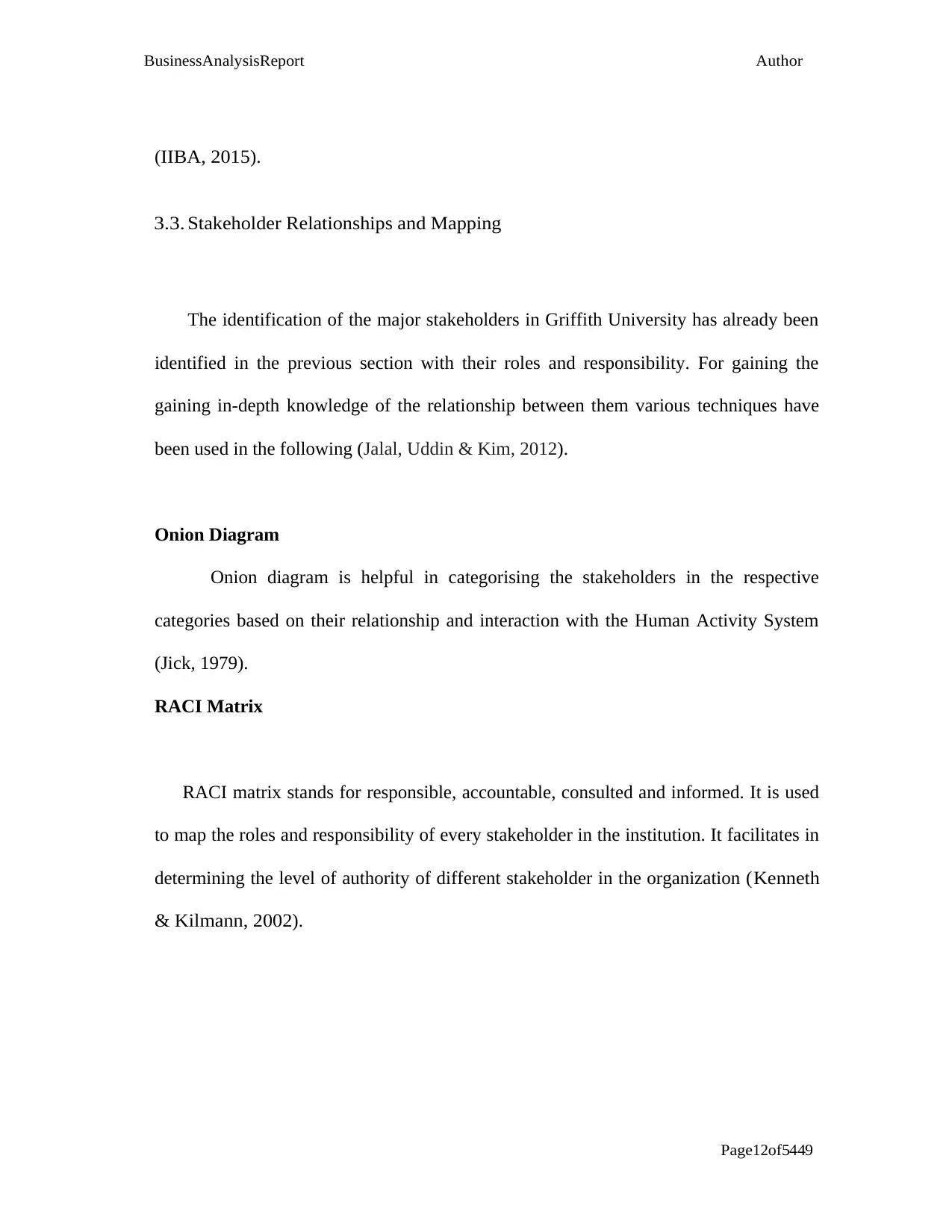
BusinessAnalysisReport Author
Page12of5449
( IIBA, 2015).
3.3. Stakeholder Relationships and Mapping
The identification of the major stakeholders in Griffith University has already been
identified in the previous section with their roles and responsibility. For gaining the
gaining in-depth knowledge of the relationship between them various techniques have
been used in the following (Jalal, Uddin & Kim, 2012).
Onion Diagram
Onion diagram is helpful in categorising the stakeholders in the respective
categories based on their relationship and interaction with the Human Activity System
(Jick, 1979).
RACI Matrix
RACI matrix stands for responsible, accountable, consulted and informed. It is used
to map the roles and responsibility of every stakeholder in the institution. It facilitates in
determining the level of authority of different stakeholder in the organization ( Kenneth
& Kilmann, 2002).
Page12of5449
( IIBA, 2015).
3.3. Stakeholder Relationships and Mapping
The identification of the major stakeholders in Griffith University has already been
identified in the previous section with their roles and responsibility. For gaining the
gaining in-depth knowledge of the relationship between them various techniques have
been used in the following (Jalal, Uddin & Kim, 2012).
Onion Diagram
Onion diagram is helpful in categorising the stakeholders in the respective
categories based on their relationship and interaction with the Human Activity System
(Jick, 1979).
RACI Matrix
RACI matrix stands for responsible, accountable, consulted and informed. It is used
to map the roles and responsibility of every stakeholder in the institution. It facilitates in
determining the level of authority of different stakeholder in the organization ( Kenneth
& Kilmann, 2002).
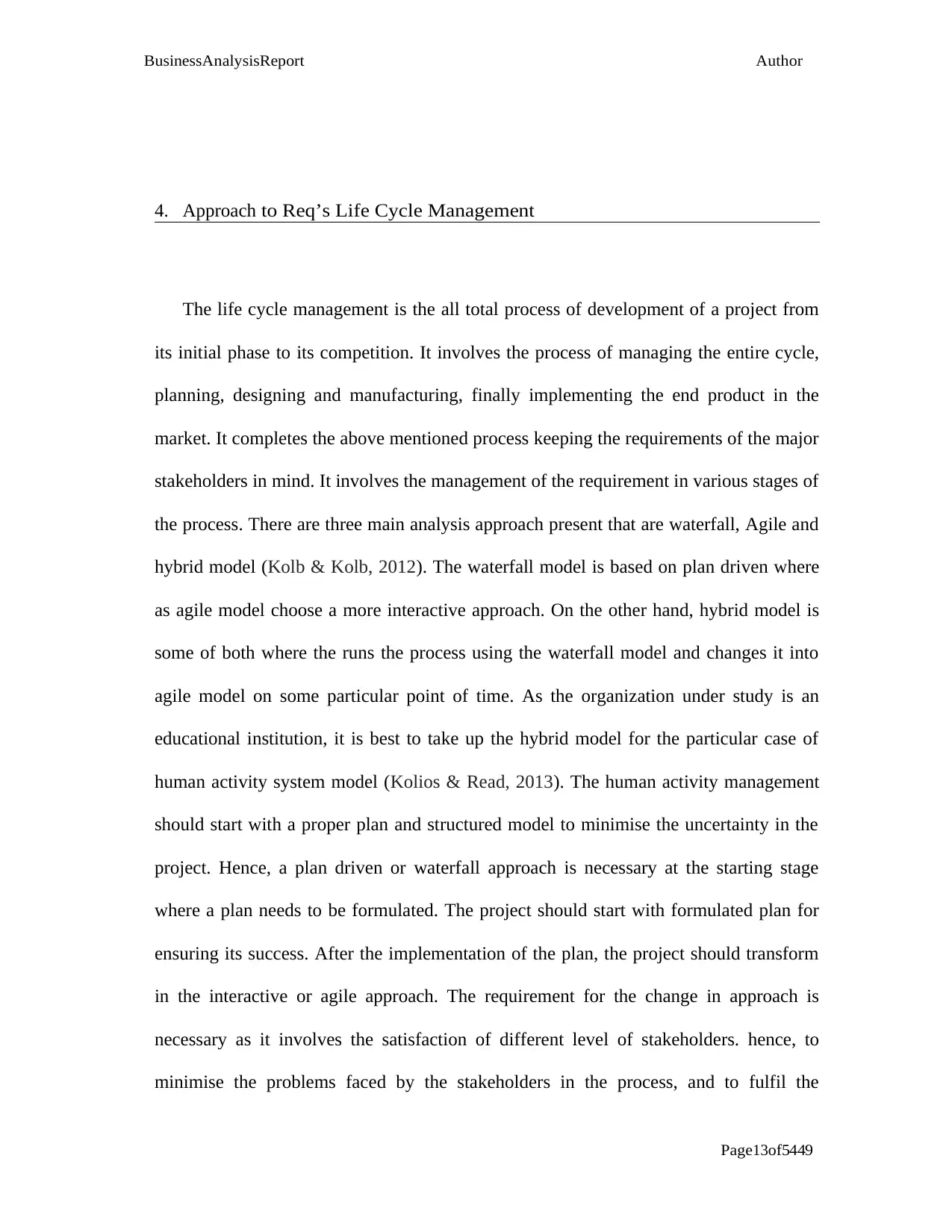
BusinessAnalysisReport Author
Page13of5449
4. Approach to Req’s Life Cycle Management
The life cycle management is the all total process of development of a project from
its initial phase to its competition. It involves the process of managing the entire cycle,
planning, designing and manufacturing, finally implementing the end product in the
market. It completes the above mentioned process keeping the requirements of the major
stakeholders in mind. It involves the management of the requirement in various stages of
the process. There are three main analysis approach present that are waterfall, Agile and
hybrid model (Kolb & Kolb, 2012). The waterfall model is based on plan driven where
as agile model choose a more interactive approach. On the other hand, hybrid model is
some of both where the runs the process using the waterfall model and changes it into
agile model on some particular point of time. As the organization under study is an
educational institution, it is best to take up the hybrid model for the particular case of
human activity system model (Kolios & Read, 2013). The human activity management
should start with a proper plan and structured model to minimise the uncertainty in the
project. Hence, a plan driven or waterfall approach is necessary at the starting stage
where a plan needs to be formulated. The project should start with formulated plan for
ensuring its success. After the implementation of the plan, the project should transform
in the interactive or agile approach. The requirement for the change in approach is
necessary as it involves the satisfaction of different level of stakeholders. hence, to
minimise the problems faced by the stakeholders in the process, and to fulfil the
Page13of5449
4. Approach to Req’s Life Cycle Management
The life cycle management is the all total process of development of a project from
its initial phase to its competition. It involves the process of managing the entire cycle,
planning, designing and manufacturing, finally implementing the end product in the
market. It completes the above mentioned process keeping the requirements of the major
stakeholders in mind. It involves the management of the requirement in various stages of
the process. There are three main analysis approach present that are waterfall, Agile and
hybrid model (Kolb & Kolb, 2012). The waterfall model is based on plan driven where
as agile model choose a more interactive approach. On the other hand, hybrid model is
some of both where the runs the process using the waterfall model and changes it into
agile model on some particular point of time. As the organization under study is an
educational institution, it is best to take up the hybrid model for the particular case of
human activity system model (Kolios & Read, 2013). The human activity management
should start with a proper plan and structured model to minimise the uncertainty in the
project. Hence, a plan driven or waterfall approach is necessary at the starting stage
where a plan needs to be formulated. The project should start with formulated plan for
ensuring its success. After the implementation of the plan, the project should transform
in the interactive or agile approach. The requirement for the change in approach is
necessary as it involves the satisfaction of different level of stakeholders. hence, to
minimise the problems faced by the stakeholders in the process, and to fulfil the
Secure Best Marks with AI Grader
Need help grading? Try our AI Grader for instant feedback on your assignments.

BusinessAnalysisReport Author
Page14of5449
requirements, hybrid model proves beneficial to meet the demands (Lara & Labrador,
2013). The process should target the intensity of the required changes that are demanded
by the stakeholders. The major stakeholders who should be given priority are the
students, lecturers, government and the administrative as they are the major stakeholders
in an educational institution (Laudon & Laudon, 2016).
Meeting the requirements of the stakeholders according to their intensity is necessary
to manage the possible conflict in the institution. The productivity should be given the
utmost importance in the process to maintain the healthy environment of the
organization. There are various possible reason for conflict which involves the
dissatisfaction of the stakeholders which can never be meet as these are interrelated with
one another. Fulfilment of some requirements will give birth to some other conflict (Li,
2014). There are five conflict handling model that are considered as the key models of
conflict management. They are competing, collaborating, compromising, avoiding and
accommodation model. These models are based on the degree assertiveness and
cooperativeness (Madsbjerg & Rasmussen, 2014).
Page14of5449
requirements, hybrid model proves beneficial to meet the demands (Lara & Labrador,
2013). The process should target the intensity of the required changes that are demanded
by the stakeholders. The major stakeholders who should be given priority are the
students, lecturers, government and the administrative as they are the major stakeholders
in an educational institution (Laudon & Laudon, 2016).
Meeting the requirements of the stakeholders according to their intensity is necessary
to manage the possible conflict in the institution. The productivity should be given the
utmost importance in the process to maintain the healthy environment of the
organization. There are various possible reason for conflict which involves the
dissatisfaction of the stakeholders which can never be meet as these are interrelated with
one another. Fulfilment of some requirements will give birth to some other conflict (Li,
2014). There are five conflict handling model that are considered as the key models of
conflict management. They are competing, collaborating, compromising, avoiding and
accommodation model. These models are based on the degree assertiveness and
cooperativeness (Madsbjerg & Rasmussen, 2014).
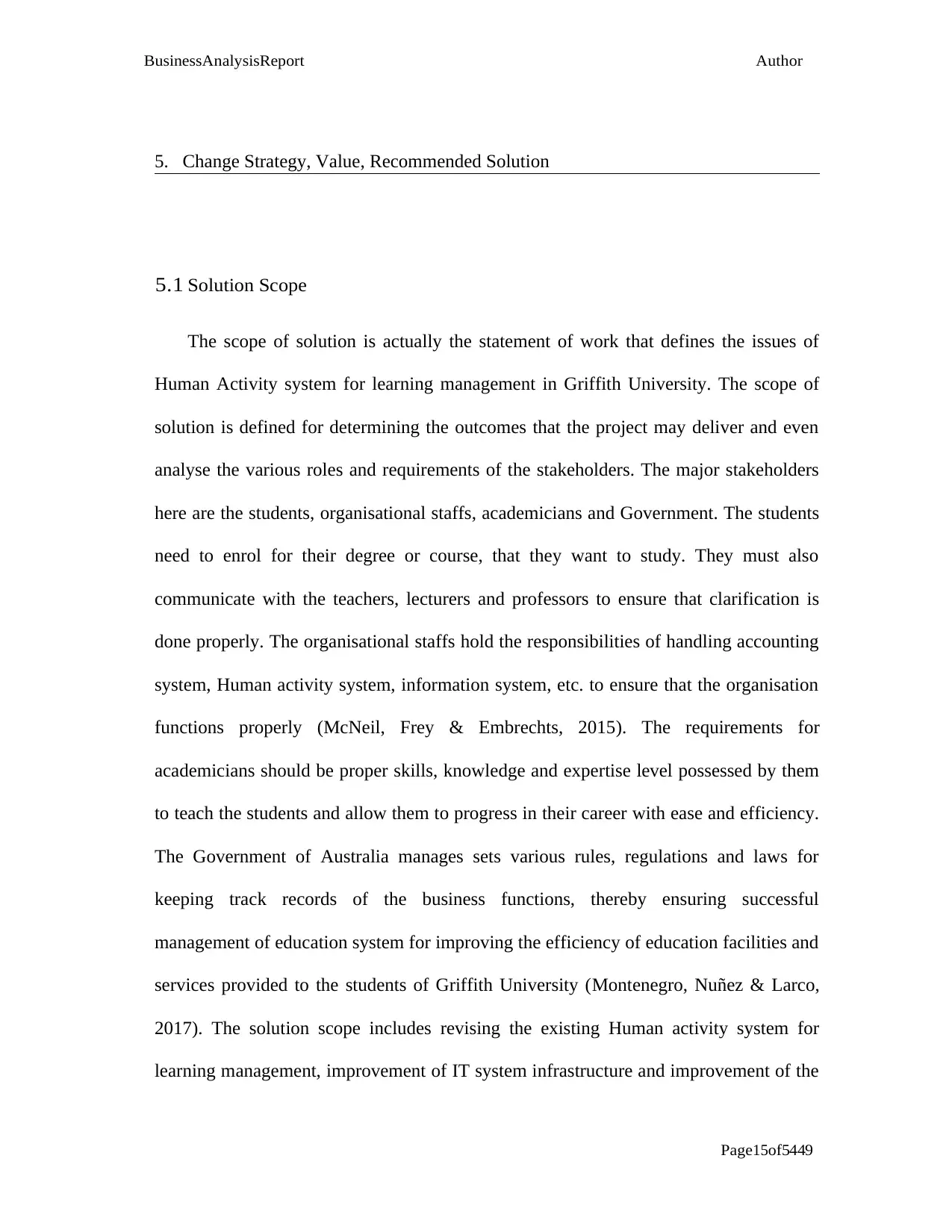
BusinessAnalysisReport Author
Page15of5449
5. Change Strategy, Value, Recommended Solution
5.1 Solution Scope
The scope of solution is actually the statement of work that defines the issues of
Human Activity system for learning management in Griffith University. The scope of
solution is defined for determining the outcomes that the project may deliver and even
analyse the various roles and requirements of the stakeholders. The major stakeholders
here are the students, organisational staffs, academicians and Government. The students
need to enrol for their degree or course, that they want to study. They must also
communicate with the teachers, lecturers and professors to ensure that clarification is
done properly. The organisational staffs hold the responsibilities of handling accounting
system, Human activity system, information system, etc. to ensure that the organisation
functions properly (McNeil, Frey & Embrechts, 2015). The requirements for
academicians should be proper skills, knowledge and expertise level possessed by them
to teach the students and allow them to progress in their career with ease and efficiency.
The Government of Australia manages sets various rules, regulations and laws for
keeping track records of the business functions, thereby ensuring successful
management of education system for improving the efficiency of education facilities and
services provided to the students of Griffith University (Montenegro, Nuñez & Larco,
2017). The solution scope includes revising the existing Human activity system for
learning management, improvement of IT system infrastructure and improvement of the
Page15of5449
5. Change Strategy, Value, Recommended Solution
5.1 Solution Scope
The scope of solution is actually the statement of work that defines the issues of
Human Activity system for learning management in Griffith University. The scope of
solution is defined for determining the outcomes that the project may deliver and even
analyse the various roles and requirements of the stakeholders. The major stakeholders
here are the students, organisational staffs, academicians and Government. The students
need to enrol for their degree or course, that they want to study. They must also
communicate with the teachers, lecturers and professors to ensure that clarification is
done properly. The organisational staffs hold the responsibilities of handling accounting
system, Human activity system, information system, etc. to ensure that the organisation
functions properly (McNeil, Frey & Embrechts, 2015). The requirements for
academicians should be proper skills, knowledge and expertise level possessed by them
to teach the students and allow them to progress in their career with ease and efficiency.
The Government of Australia manages sets various rules, regulations and laws for
keeping track records of the business functions, thereby ensuring successful
management of education system for improving the efficiency of education facilities and
services provided to the students of Griffith University (Montenegro, Nuñez & Larco,
2017). The solution scope includes revising the existing Human activity system for
learning management, improvement of IT system infrastructure and improvement of the
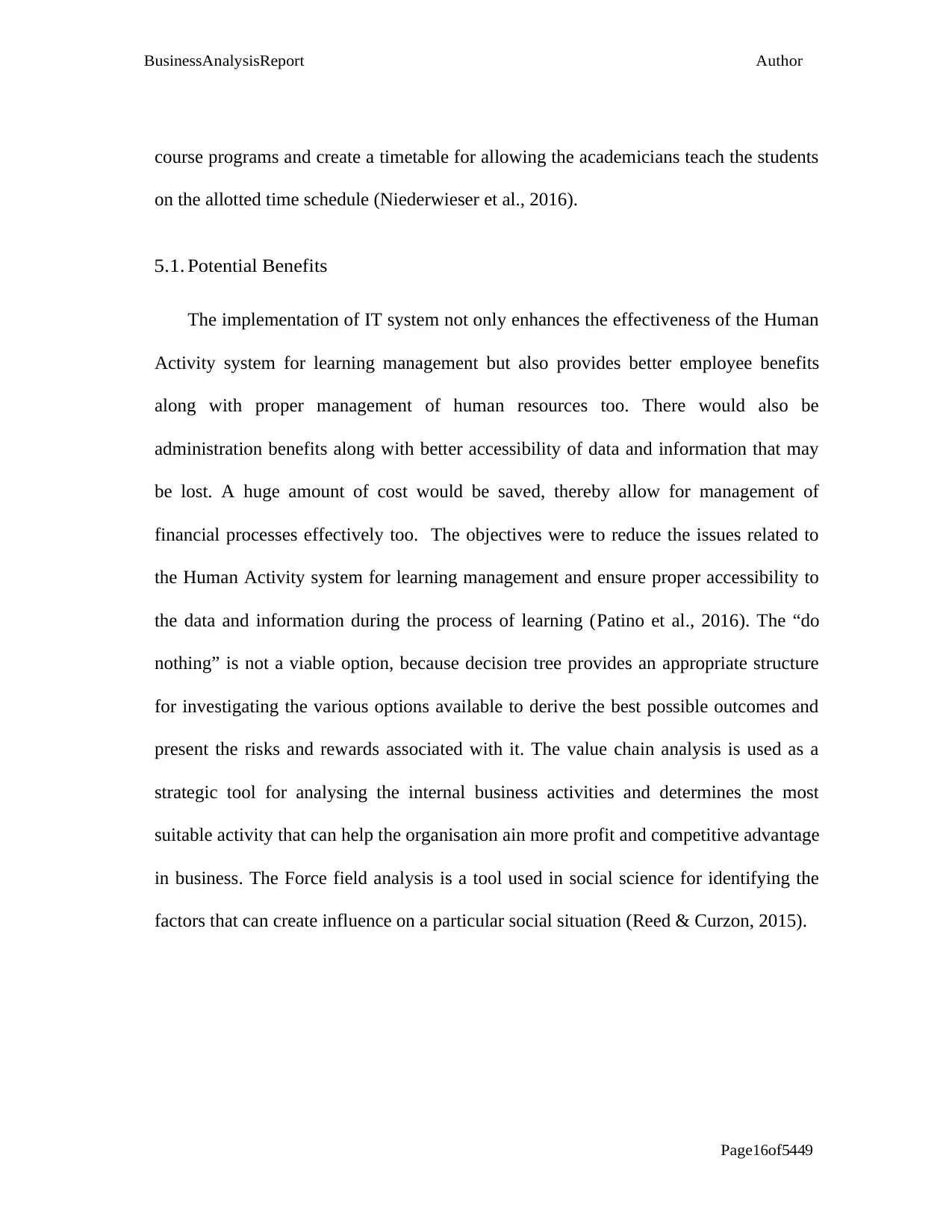
BusinessAnalysisReport Author
Page16of5449
course programs and create a timetable for allowing the academicians teach the students
on the allotted time schedule (Niederwieser et al., 2016).
5.1. Potential Benefits
The implementation of IT system not only enhances the effectiveness of the Human
Activity system for learning management but also provides better employee benefits
along with proper management of human resources too. There would also be
administration benefits along with better accessibility of data and information that may
be lost. A huge amount of cost would be saved, thereby allow for management of
financial processes effectively too. The objectives were to reduce the issues related to
the Human Activity system for learning management and ensure proper accessibility to
the data and information during the process of learning (Patino et al., 2016). The “do
nothing” is not a viable option, because decision tree provides an appropriate structure
for investigating the various options available to derive the best possible outcomes and
present the risks and rewards associated with it. The value chain analysis is used as a
strategic tool for analysing the internal business activities and determines the most
suitable activity that can help the organisation ain more profit and competitive advantage
in business. The Force field analysis is a tool used in social science for identifying the
factors that can create influence on a particular social situation (Reed & Curzon, 2015).
Page16of5449
course programs and create a timetable for allowing the academicians teach the students
on the allotted time schedule (Niederwieser et al., 2016).
5.1. Potential Benefits
The implementation of IT system not only enhances the effectiveness of the Human
Activity system for learning management but also provides better employee benefits
along with proper management of human resources too. There would also be
administration benefits along with better accessibility of data and information that may
be lost. A huge amount of cost would be saved, thereby allow for management of
financial processes effectively too. The objectives were to reduce the issues related to
the Human Activity system for learning management and ensure proper accessibility to
the data and information during the process of learning (Patino et al., 2016). The “do
nothing” is not a viable option, because decision tree provides an appropriate structure
for investigating the various options available to derive the best possible outcomes and
present the risks and rewards associated with it. The value chain analysis is used as a
strategic tool for analysing the internal business activities and determines the most
suitable activity that can help the organisation ain more profit and competitive advantage
in business. The Force field analysis is a tool used in social science for identifying the
factors that can create influence on a particular social situation (Reed & Curzon, 2015).
Paraphrase This Document
Need a fresh take? Get an instant paraphrase of this document with our AI Paraphraser

BusinessAnalysisReport Author
Page17of5449
5.2. Risk Assessment
The topic focuses on the issues associated with the Human Activity system for
learning management and thus it is essential for the organisation to manage the risk
assessment procedure for evaluating the issues that are causing the risks. The risk
assessment can also help in determining the probable risks incurred during the
business operations and develop mitigation strategies to reduce the chances of risks
efficiently (Satzinger, Jackson & Burd, 2012).
Page17of5449
5.2. Risk Assessment
The topic focuses on the issues associated with the Human Activity system for
learning management and thus it is essential for the organisation to manage the risk
assessment procedure for evaluating the issues that are causing the risks. The risk
assessment can also help in determining the probable risks incurred during the
business operations and develop mitigation strategies to reduce the chances of risks
efficiently (Satzinger, Jackson & Burd, 2012).
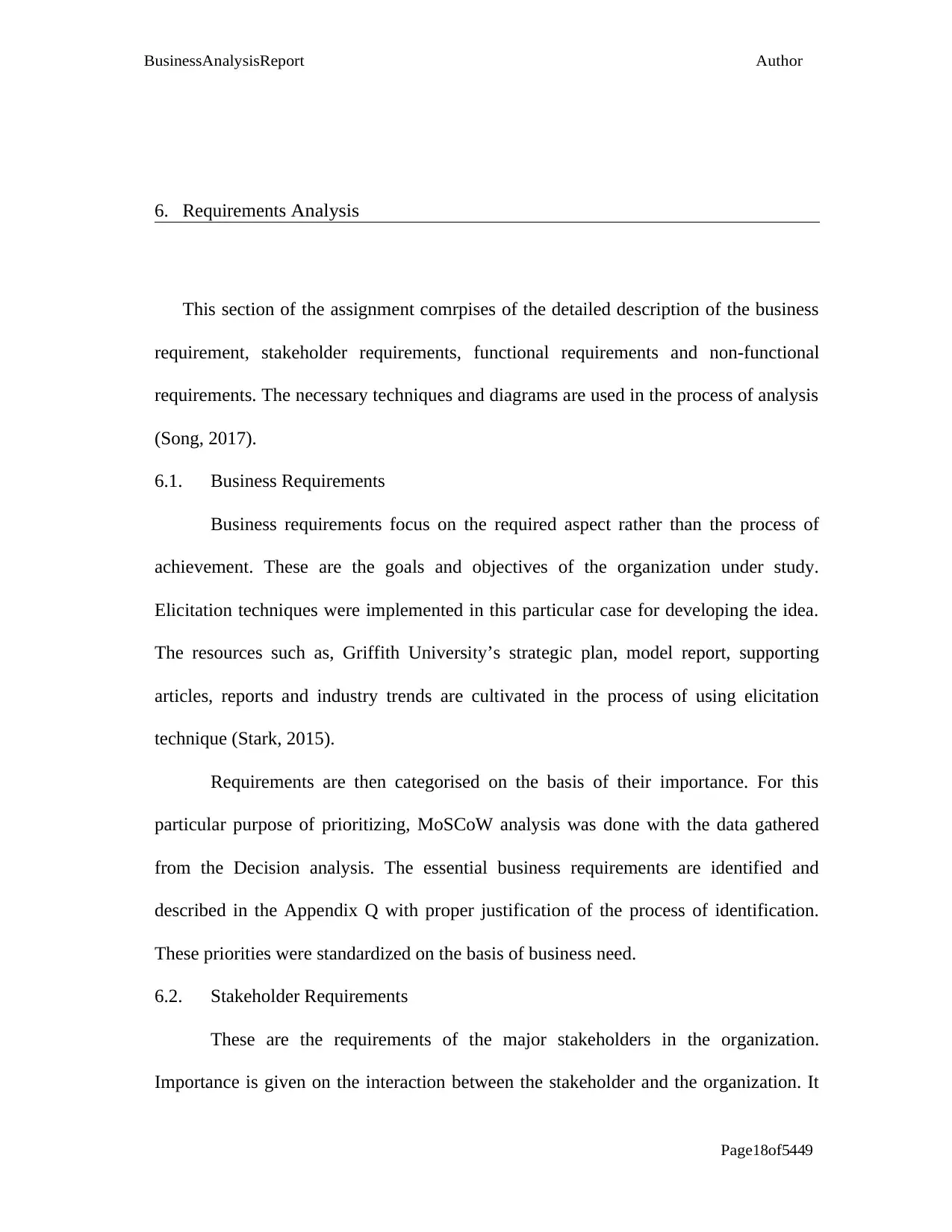
BusinessAnalysisReport Author
Page18of5449
6. Requirements Analysis
This section of the assignment comrpises of the detailed description of the business
requirement, stakeholder requirements, functional requirements and non-functional
requirements. The necessary techniques and diagrams are used in the process of analysis
(Song, 2017).
6.1. Business Requirements
Business requirements focus on the required aspect rather than the process of
achievement. These are the goals and objectives of the organization under study.
Elicitation techniques were implemented in this particular case for developing the idea.
The resources such as, Griffith University’s strategic plan, model report, supporting
articles, reports and industry trends are cultivated in the process of using elicitation
technique (Stark, 2015).
Requirements are then categorised on the basis of their importance. For this
particular purpose of prioritizing, MoSCoW analysis was done with the data gathered
from the Decision analysis. The essential business requirements are identified and
described in the Appendix Q with proper justification of the process of identification.
These priorities were standardized on the basis of business need.
6.2. Stakeholder Requirements
These are the requirements of the major stakeholders in the organization.
Importance is given on the interaction between the stakeholder and the organization. It
Page18of5449
6. Requirements Analysis
This section of the assignment comrpises of the detailed description of the business
requirement, stakeholder requirements, functional requirements and non-functional
requirements. The necessary techniques and diagrams are used in the process of analysis
(Song, 2017).
6.1. Business Requirements
Business requirements focus on the required aspect rather than the process of
achievement. These are the goals and objectives of the organization under study.
Elicitation techniques were implemented in this particular case for developing the idea.
The resources such as, Griffith University’s strategic plan, model report, supporting
articles, reports and industry trends are cultivated in the process of using elicitation
technique (Stark, 2015).
Requirements are then categorised on the basis of their importance. For this
particular purpose of prioritizing, MoSCoW analysis was done with the data gathered
from the Decision analysis. The essential business requirements are identified and
described in the Appendix Q with proper justification of the process of identification.
These priorities were standardized on the basis of business need.
6.2. Stakeholder Requirements
These are the requirements of the major stakeholders in the organization.
Importance is given on the interaction between the stakeholder and the organization. It
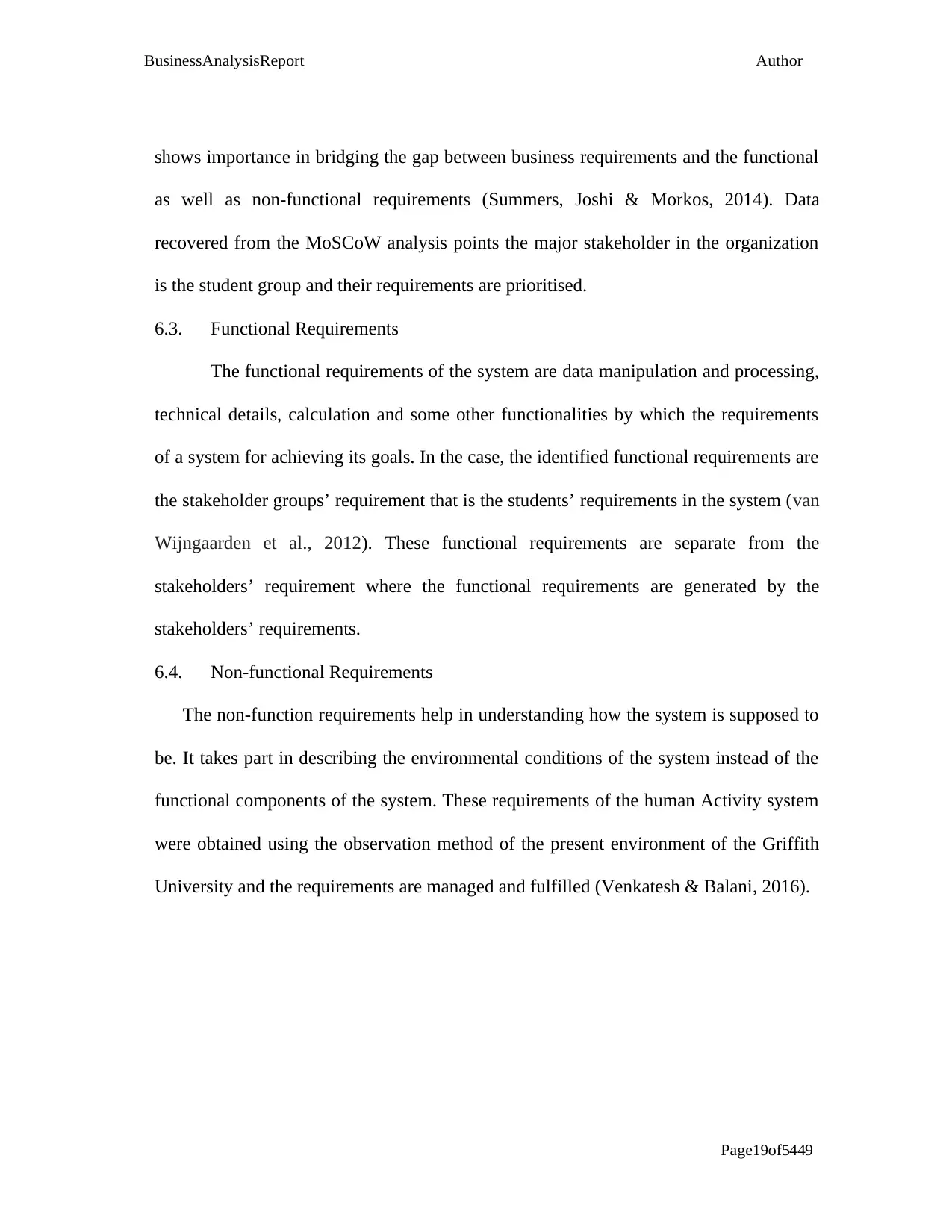
BusinessAnalysisReport Author
Page19of5449
shows importance in bridging the gap between business requirements and the functional
as well as non-functional requirements (Summers, Joshi & Morkos, 2014). Data
recovered from the MoSCoW analysis points the major stakeholder in the organization
is the student group and their requirements are prioritised.
6.3. Functional Requirements
The functional requirements of the system are data manipulation and processing,
technical details, calculation and some other functionalities by which the requirements
of a system for achieving its goals. In the case, the identified functional requirements are
the stakeholder groups’ requirement that is the students’ requirements in the system (van
Wijngaarden et al., 2012). These functional requirements are separate from the
stakeholders’ requirement where the functional requirements are generated by the
stakeholders’ requirements.
6.4. Non-functional Requirements
The non-function requirements help in understanding how the system is supposed to
be. It takes part in describing the environmental conditions of the system instead of the
functional components of the system. These requirements of the human Activity system
were obtained using the observation method of the present environment of the Griffith
University and the requirements are managed and fulfilled (Venkatesh & Balani, 2016).
Page19of5449
shows importance in bridging the gap between business requirements and the functional
as well as non-functional requirements (Summers, Joshi & Morkos, 2014). Data
recovered from the MoSCoW analysis points the major stakeholder in the organization
is the student group and their requirements are prioritised.
6.3. Functional Requirements
The functional requirements of the system are data manipulation and processing,
technical details, calculation and some other functionalities by which the requirements
of a system for achieving its goals. In the case, the identified functional requirements are
the stakeholder groups’ requirement that is the students’ requirements in the system (van
Wijngaarden et al., 2012). These functional requirements are separate from the
stakeholders’ requirement where the functional requirements are generated by the
stakeholders’ requirements.
6.4. Non-functional Requirements
The non-function requirements help in understanding how the system is supposed to
be. It takes part in describing the environmental conditions of the system instead of the
functional components of the system. These requirements of the human Activity system
were obtained using the observation method of the present environment of the Griffith
University and the requirements are managed and fulfilled (Venkatesh & Balani, 2016).
Secure Best Marks with AI Grader
Need help grading? Try our AI Grader for instant feedback on your assignments.
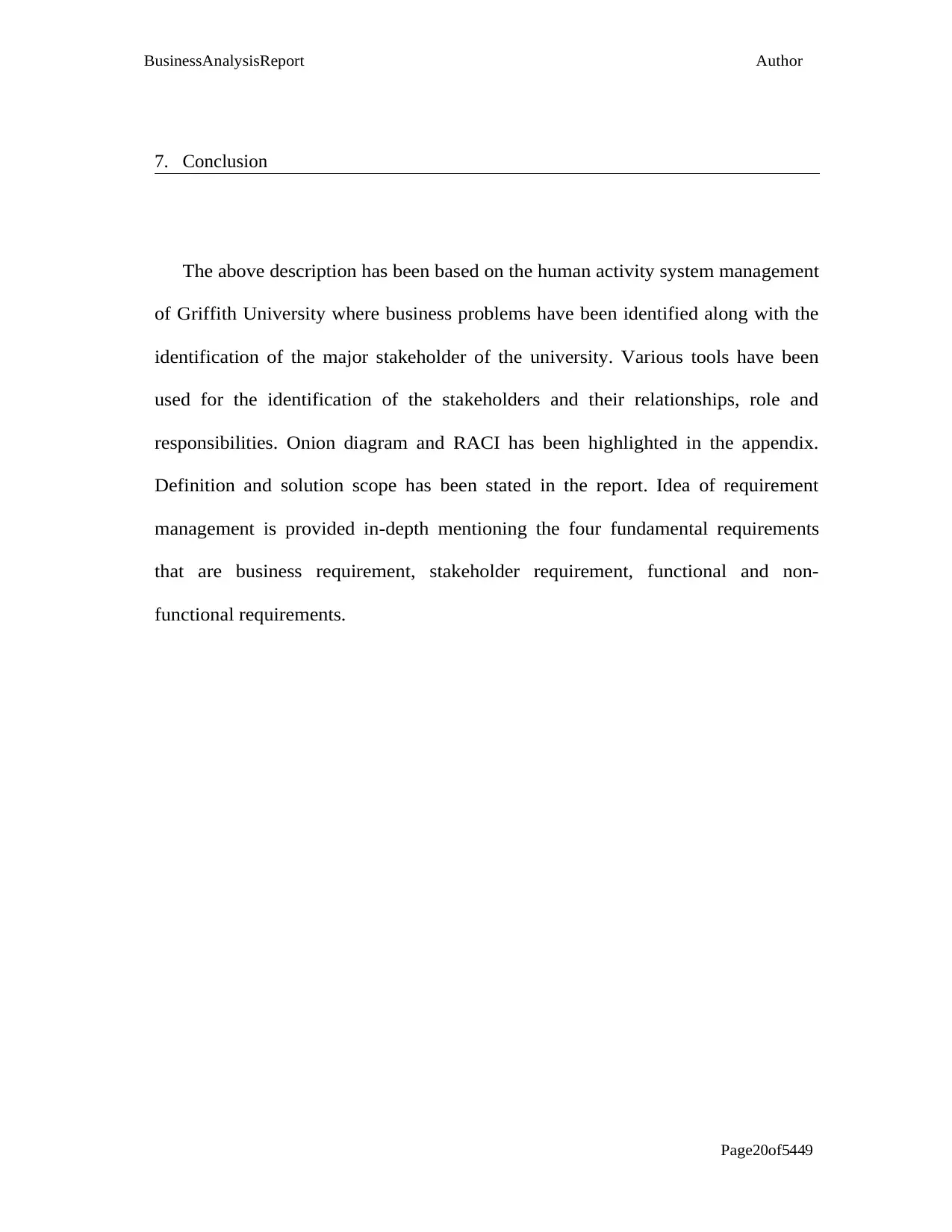
BusinessAnalysisReport Author
Page20of5449
7. Conclusion
The above description has been based on the human activity system management
of Griffith University where business problems have been identified along with the
identification of the major stakeholder of the university. Various tools have been
used for the identification of the stakeholders and their relationships, role and
responsibilities. Onion diagram and RACI has been highlighted in the appendix.
Definition and solution scope has been stated in the report. Idea of requirement
management is provided in-depth mentioning the four fundamental requirements
that are business requirement, stakeholder requirement, functional and non-
functional requirements.
Page20of5449
7. Conclusion
The above description has been based on the human activity system management
of Griffith University where business problems have been identified along with the
identification of the major stakeholder of the university. Various tools have been
used for the identification of the stakeholders and their relationships, role and
responsibilities. Onion diagram and RACI has been highlighted in the appendix.
Definition and solution scope has been stated in the report. Idea of requirement
management is provided in-depth mentioning the four fundamental requirements
that are business requirement, stakeholder requirement, functional and non-
functional requirements.
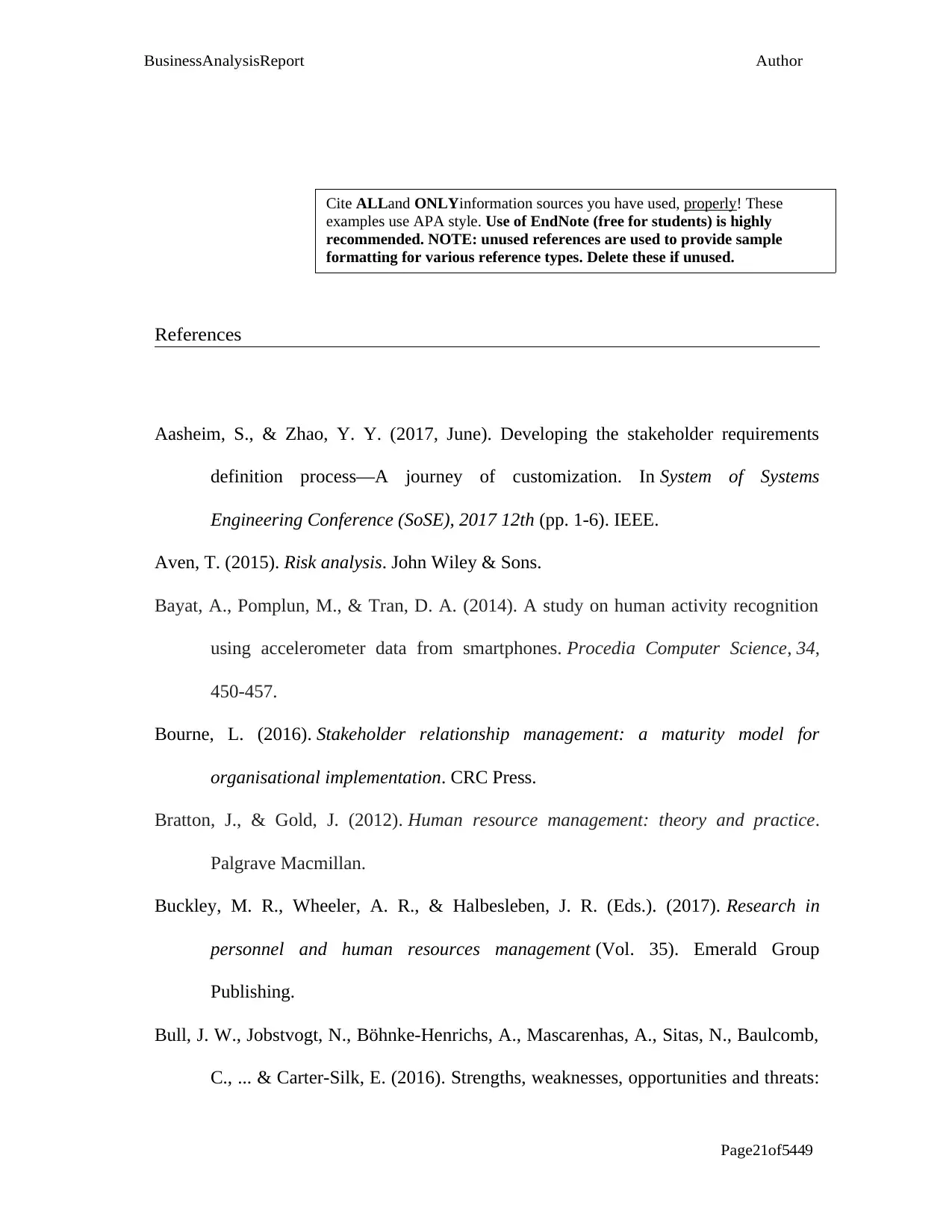
BusinessAnalysisReport Author
Page21of5449
References
Aasheim, S., & Zhao, Y. Y. (2017, June). Developing the stakeholder requirements
definition process—A journey of customization. In System of Systems
Engineering Conference (SoSE), 2017 12th (pp. 1-6). IEEE.
Aven, T. (2015). Risk analysis. John Wiley & Sons.
Bayat, A., Pomplun, M., & Tran, D. A. (2014). A study on human activity recognition
using accelerometer data from smartphones. Procedia Computer Science, 34,
450-457.
Bourne, L. (2016). Stakeholder relationship management: a maturity model for
organisational implementation. CRC Press.
Bratton, J., & Gold, J. (2012). Human resource management: theory and practice.
Palgrave Macmillan.
Buckley, M. R., Wheeler, A. R., & Halbesleben, J. R. (Eds.). (2017). Research in
personnel and human resources management (Vol. 35). Emerald Group
Publishing.
Bull, J. W., Jobstvogt, N., Böhnke-Henrichs, A., Mascarenhas, A., Sitas, N., Baulcomb,
C., ... & Carter-Silk, E. (2016). Strengths, weaknesses, opportunities and threats:
Cite ALLand ONLYinformation sources you have used, properly! These
examples use APA style. Use of EndNote (free for students) is highly
recommended. NOTE: unused references are used to provide sample
formatting for various reference types. Delete these if unused.
Page21of5449
References
Aasheim, S., & Zhao, Y. Y. (2017, June). Developing the stakeholder requirements
definition process—A journey of customization. In System of Systems
Engineering Conference (SoSE), 2017 12th (pp. 1-6). IEEE.
Aven, T. (2015). Risk analysis. John Wiley & Sons.
Bayat, A., Pomplun, M., & Tran, D. A. (2014). A study on human activity recognition
using accelerometer data from smartphones. Procedia Computer Science, 34,
450-457.
Bourne, L. (2016). Stakeholder relationship management: a maturity model for
organisational implementation. CRC Press.
Bratton, J., & Gold, J. (2012). Human resource management: theory and practice.
Palgrave Macmillan.
Buckley, M. R., Wheeler, A. R., & Halbesleben, J. R. (Eds.). (2017). Research in
personnel and human resources management (Vol. 35). Emerald Group
Publishing.
Bull, J. W., Jobstvogt, N., Böhnke-Henrichs, A., Mascarenhas, A., Sitas, N., Baulcomb,
C., ... & Carter-Silk, E. (2016). Strengths, weaknesses, opportunities and threats:
Cite ALLand ONLYinformation sources you have used, properly! These
examples use APA style. Use of EndNote (free for students) is highly
recommended. NOTE: unused references are used to provide sample
formatting for various reference types. Delete these if unused.
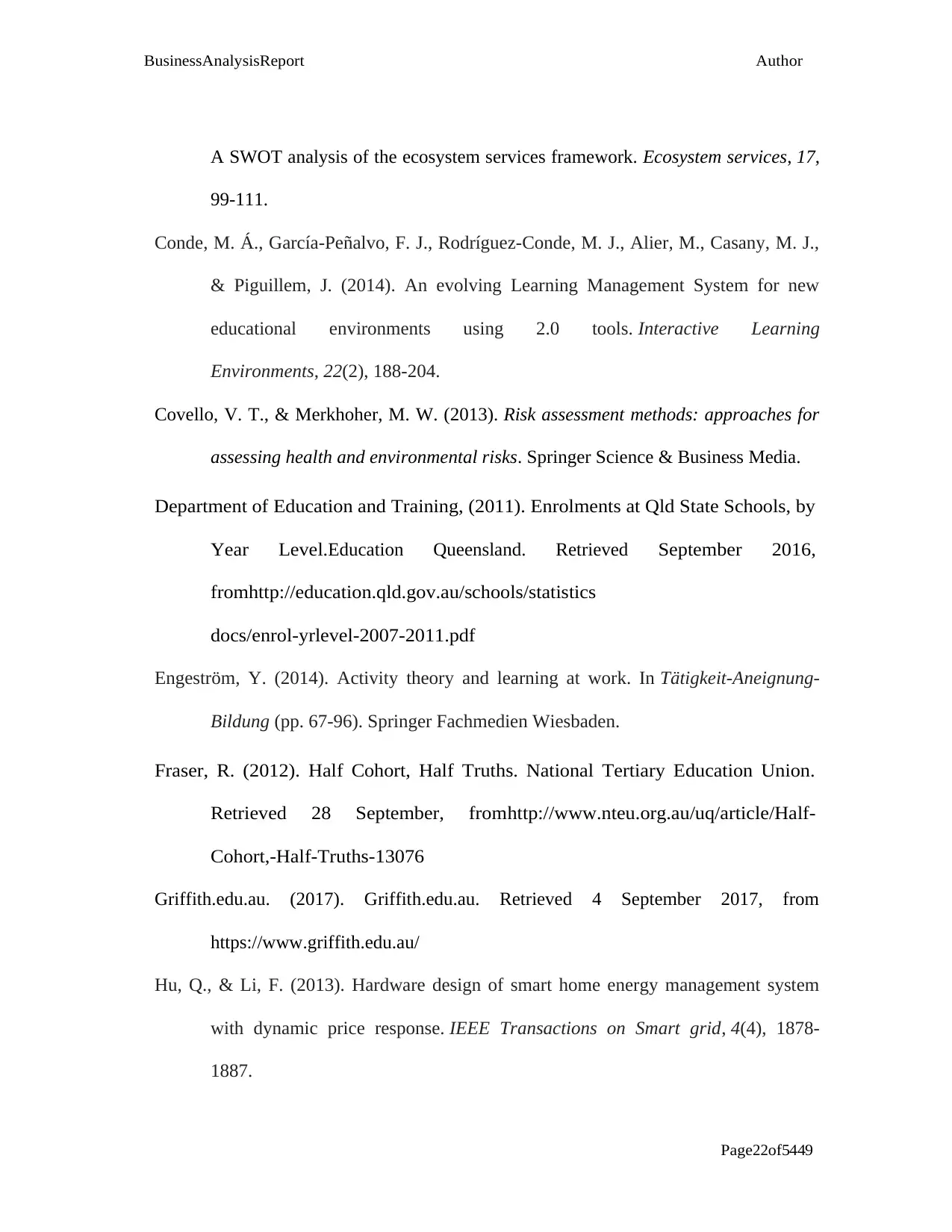
BusinessAnalysisReport Author
Page22of5449
A SWOT analysis of the ecosystem services framework. Ecosystem services, 17,
99-111.
Conde, M. Á., García-Peñalvo, F. J., Rodríguez-Conde, M. J., Alier, M., Casany, M. J.,
& Piguillem, J. (2014). An evolving Learning Management System for new
educational environments using 2.0 tools. Interactive Learning
Environments, 22(2), 188-204.
Covello, V. T., & Merkhoher, M. W. (2013). Risk assessment methods: approaches for
assessing health and environmental risks. Springer Science & Business Media.
Department of Education and Training, (2011). Enrolments at Qld State Schools, by
Year Level.Education Queensland. Retrieved September 2016,
fromhttp://education.qld.gov.au/schools/statistics
docs/enrol-yrlevel-2007-2011.pdf
Engeström, Y. (2014). Activity theory and learning at work. In Tätigkeit-Aneignung-
Bildung (pp. 67-96). Springer Fachmedien Wiesbaden.
Fraser, R. (2012). Half Cohort, Half Truths. National Tertiary Education Union.
Retrieved 28 September, fromhttp://www.nteu.org.au/uq/article/Half-
Cohort,-Half-Truths-13076
Griffith.edu.au. (2017). Griffith.edu.au. Retrieved 4 September 2017, from
https://www.griffith.edu.au/
Hu, Q., & Li, F. (2013). Hardware design of smart home energy management system
with dynamic price response. IEEE Transactions on Smart grid, 4(4), 1878-
1887.
Page22of5449
A SWOT analysis of the ecosystem services framework. Ecosystem services, 17,
99-111.
Conde, M. Á., García-Peñalvo, F. J., Rodríguez-Conde, M. J., Alier, M., Casany, M. J.,
& Piguillem, J. (2014). An evolving Learning Management System for new
educational environments using 2.0 tools. Interactive Learning
Environments, 22(2), 188-204.
Covello, V. T., & Merkhoher, M. W. (2013). Risk assessment methods: approaches for
assessing health and environmental risks. Springer Science & Business Media.
Department of Education and Training, (2011). Enrolments at Qld State Schools, by
Year Level.Education Queensland. Retrieved September 2016,
fromhttp://education.qld.gov.au/schools/statistics
docs/enrol-yrlevel-2007-2011.pdf
Engeström, Y. (2014). Activity theory and learning at work. In Tätigkeit-Aneignung-
Bildung (pp. 67-96). Springer Fachmedien Wiesbaden.
Fraser, R. (2012). Half Cohort, Half Truths. National Tertiary Education Union.
Retrieved 28 September, fromhttp://www.nteu.org.au/uq/article/Half-
Cohort,-Half-Truths-13076
Griffith.edu.au. (2017). Griffith.edu.au. Retrieved 4 September 2017, from
https://www.griffith.edu.au/
Hu, Q., & Li, F. (2013). Hardware design of smart home energy management system
with dynamic price response. IEEE Transactions on Smart grid, 4(4), 1878-
1887.
Paraphrase This Document
Need a fresh take? Get an instant paraphrase of this document with our AI Paraphraser
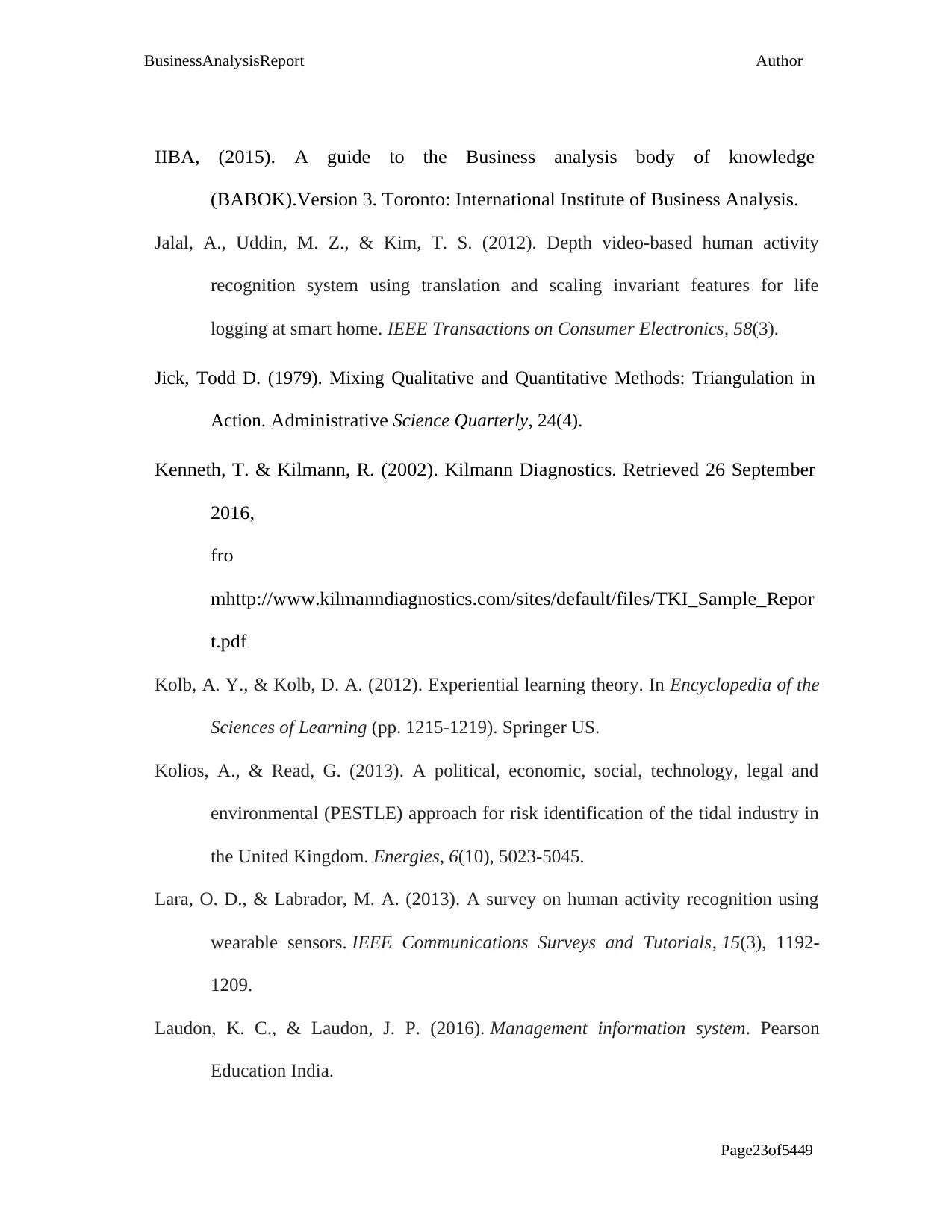
BusinessAnalysisReport Author
Page23of5449
IIBA, (2015). A guide to the Business analysis body of knowledge
(BABOK).Version 3. Toronto: International Institute of Business Analysis.
Jalal, A., Uddin, M. Z., & Kim, T. S. (2012). Depth video-based human activity
recognition system using translation and scaling invariant features for life
logging at smart home. IEEE Transactions on Consumer Electronics, 58(3).
Jick, Todd D. (1979). Mixing Qualitative and Quantitative Methods: Triangulation in
Action. Administrative Science Quarterly, 24(4).
Kenneth, T. & Kilmann, R. (2002). Kilmann Diagnostics. Retrieved 26 September
2016,
fro
mhttp://www.kilmanndiagnostics.com/sites/default/files/TKI_Sample_Repor
t.pdf
Kolb, A. Y., & Kolb, D. A. (2012). Experiential learning theory. In Encyclopedia of the
Sciences of Learning (pp. 1215-1219). Springer US.
Kolios, A., & Read, G. (2013). A political, economic, social, technology, legal and
environmental (PESTLE) approach for risk identification of the tidal industry in
the United Kingdom. Energies, 6(10), 5023-5045.
Lara, O. D., & Labrador, M. A. (2013). A survey on human activity recognition using
wearable sensors. IEEE Communications Surveys and Tutorials, 15(3), 1192-
1209.
Laudon, K. C., & Laudon, J. P. (2016). Management information system. Pearson
Education India.
Page23of5449
IIBA, (2015). A guide to the Business analysis body of knowledge
(BABOK).Version 3. Toronto: International Institute of Business Analysis.
Jalal, A., Uddin, M. Z., & Kim, T. S. (2012). Depth video-based human activity
recognition system using translation and scaling invariant features for life
logging at smart home. IEEE Transactions on Consumer Electronics, 58(3).
Jick, Todd D. (1979). Mixing Qualitative and Quantitative Methods: Triangulation in
Action. Administrative Science Quarterly, 24(4).
Kenneth, T. & Kilmann, R. (2002). Kilmann Diagnostics. Retrieved 26 September
2016,
fro
mhttp://www.kilmanndiagnostics.com/sites/default/files/TKI_Sample_Repor
t.pdf
Kolb, A. Y., & Kolb, D. A. (2012). Experiential learning theory. In Encyclopedia of the
Sciences of Learning (pp. 1215-1219). Springer US.
Kolios, A., & Read, G. (2013). A political, economic, social, technology, legal and
environmental (PESTLE) approach for risk identification of the tidal industry in
the United Kingdom. Energies, 6(10), 5023-5045.
Lara, O. D., & Labrador, M. A. (2013). A survey on human activity recognition using
wearable sensors. IEEE Communications Surveys and Tutorials, 15(3), 1192-
1209.
Laudon, K. C., & Laudon, J. P. (2016). Management information system. Pearson
Education India.
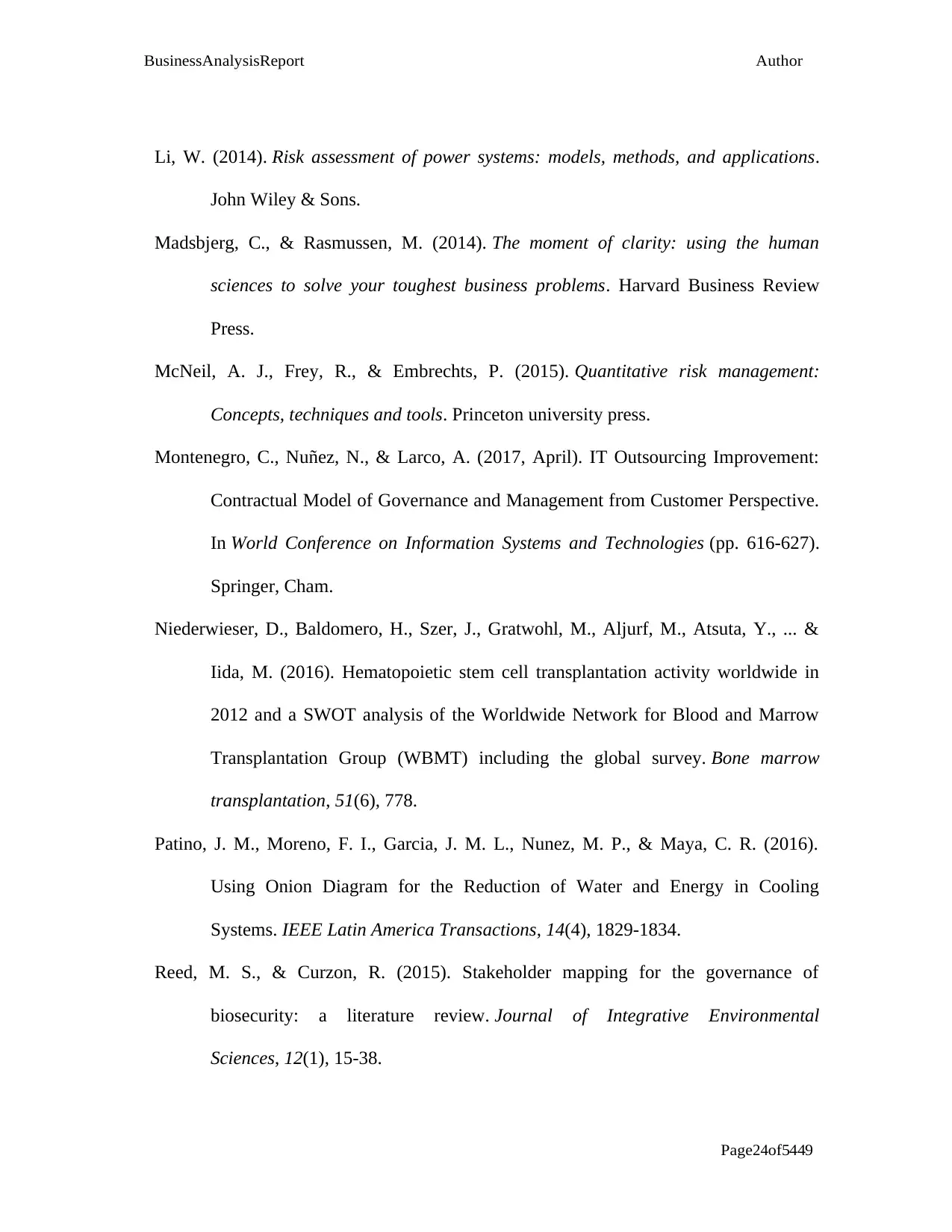
BusinessAnalysisReport Author
Page24of5449
Li, W. (2014). Risk assessment of power systems: models, methods, and applications.
John Wiley & Sons.
Madsbjerg, C., & Rasmussen, M. (2014). The moment of clarity: using the human
sciences to solve your toughest business problems. Harvard Business Review
Press.
McNeil, A. J., Frey, R., & Embrechts, P. (2015). Quantitative risk management:
Concepts, techniques and tools. Princeton university press.
Montenegro, C., Nuñez, N., & Larco, A. (2017, April). IT Outsourcing Improvement:
Contractual Model of Governance and Management from Customer Perspective.
In World Conference on Information Systems and Technologies (pp. 616-627).
Springer, Cham.
Niederwieser, D., Baldomero, H., Szer, J., Gratwohl, M., Aljurf, M., Atsuta, Y., ... &
Iida, M. (2016). Hematopoietic stem cell transplantation activity worldwide in
2012 and a SWOT analysis of the Worldwide Network for Blood and Marrow
Transplantation Group (WBMT) including the global survey. Bone marrow
transplantation, 51(6), 778.
Patino, J. M., Moreno, F. I., Garcia, J. M. L., Nunez, M. P., & Maya, C. R. (2016).
Using Onion Diagram for the Reduction of Water and Energy in Cooling
Systems. IEEE Latin America Transactions, 14(4), 1829-1834.
Reed, M. S., & Curzon, R. (2015). Stakeholder mapping for the governance of
biosecurity: a literature review. Journal of Integrative Environmental
Sciences, 12(1), 15-38.
Page24of5449
Li, W. (2014). Risk assessment of power systems: models, methods, and applications.
John Wiley & Sons.
Madsbjerg, C., & Rasmussen, M. (2014). The moment of clarity: using the human
sciences to solve your toughest business problems. Harvard Business Review
Press.
McNeil, A. J., Frey, R., & Embrechts, P. (2015). Quantitative risk management:
Concepts, techniques and tools. Princeton university press.
Montenegro, C., Nuñez, N., & Larco, A. (2017, April). IT Outsourcing Improvement:
Contractual Model of Governance and Management from Customer Perspective.
In World Conference on Information Systems and Technologies (pp. 616-627).
Springer, Cham.
Niederwieser, D., Baldomero, H., Szer, J., Gratwohl, M., Aljurf, M., Atsuta, Y., ... &
Iida, M. (2016). Hematopoietic stem cell transplantation activity worldwide in
2012 and a SWOT analysis of the Worldwide Network for Blood and Marrow
Transplantation Group (WBMT) including the global survey. Bone marrow
transplantation, 51(6), 778.
Patino, J. M., Moreno, F. I., Garcia, J. M. L., Nunez, M. P., & Maya, C. R. (2016).
Using Onion Diagram for the Reduction of Water and Energy in Cooling
Systems. IEEE Latin America Transactions, 14(4), 1829-1834.
Reed, M. S., & Curzon, R. (2015). Stakeholder mapping for the governance of
biosecurity: a literature review. Journal of Integrative Environmental
Sciences, 12(1), 15-38.
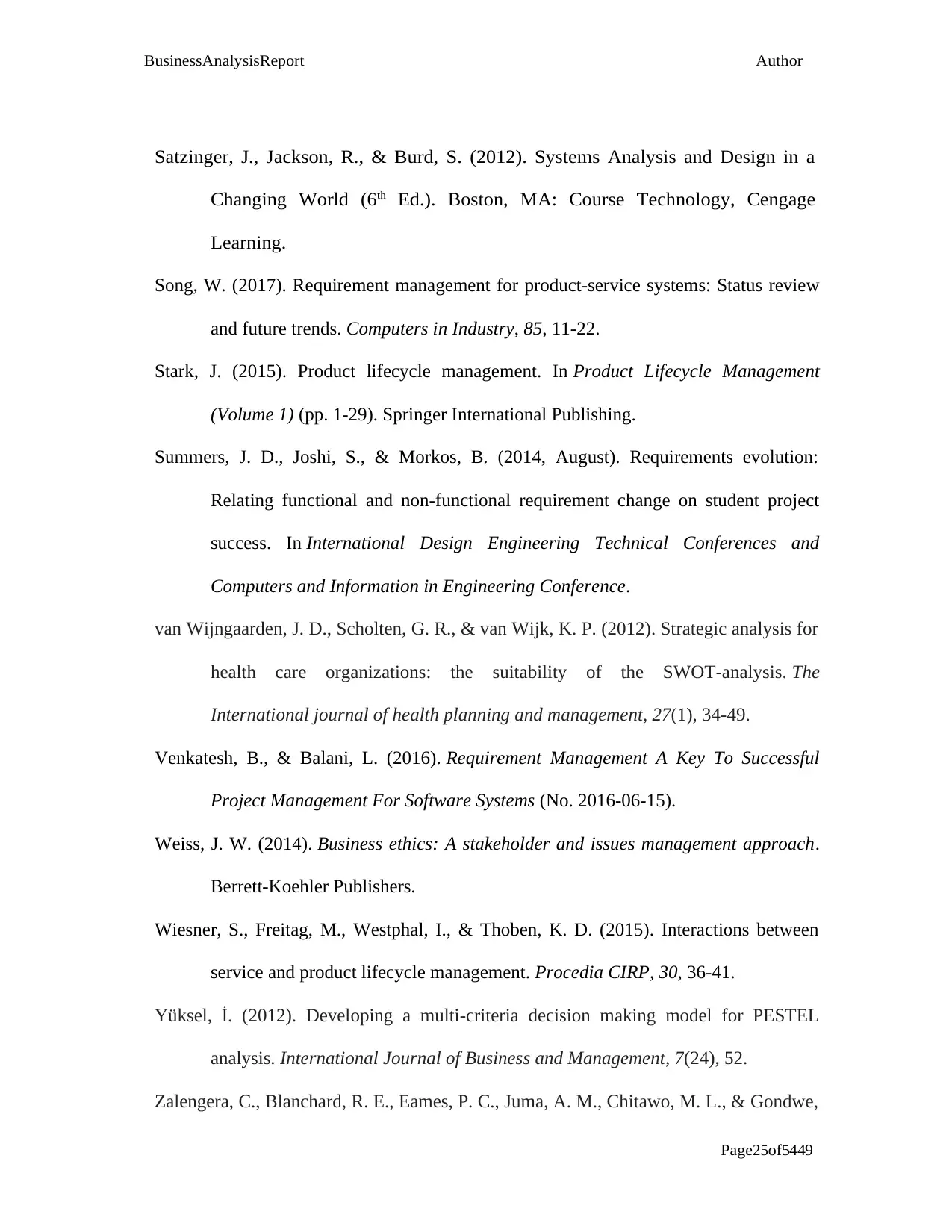
BusinessAnalysisReport Author
Page25of5449
Satzinger, J., Jackson, R., & Burd, S. (2012). Systems Analysis and Design in a
Changing World (6 th Ed.). Boston, MA: Course Technology, Cengage
Learning.
Song, W. (2017). Requirement management for product-service systems: Status review
and future trends. Computers in Industry, 85, 11-22.
Stark, J. (2015). Product lifecycle management. In Product Lifecycle Management
(Volume 1) (pp. 1-29). Springer International Publishing.
Summers, J. D., Joshi, S., & Morkos, B. (2014, August). Requirements evolution:
Relating functional and non-functional requirement change on student project
success. In International Design Engineering Technical Conferences and
Computers and Information in Engineering Conference.
van Wijngaarden, J. D., Scholten, G. R., & van Wijk, K. P. (2012). Strategic analysis for
health care organizations: the suitability of the SWOT‐analysis. The
International journal of health planning and management, 27(1), 34-49.
Venkatesh, B., & Balani, L. (2016). Requirement Management A Key To Successful
Project Management For Software Systems (No. 2016-06-15).
Weiss, J. W. (2014). Business ethics: A stakeholder and issues management approach.
Berrett-Koehler Publishers.
Wiesner, S., Freitag, M., Westphal, I., & Thoben, K. D. (2015). Interactions between
service and product lifecycle management. Procedia CIRP, 30, 36-41.
Yüksel, İ. (2012). Developing a multi-criteria decision making model for PESTEL
analysis. International Journal of Business and Management, 7(24), 52.
Zalengera, C., Blanchard, R. E., Eames, P. C., Juma, A. M., Chitawo, M. L., & Gondwe,
Page25of5449
Satzinger, J., Jackson, R., & Burd, S. (2012). Systems Analysis and Design in a
Changing World (6 th Ed.). Boston, MA: Course Technology, Cengage
Learning.
Song, W. (2017). Requirement management for product-service systems: Status review
and future trends. Computers in Industry, 85, 11-22.
Stark, J. (2015). Product lifecycle management. In Product Lifecycle Management
(Volume 1) (pp. 1-29). Springer International Publishing.
Summers, J. D., Joshi, S., & Morkos, B. (2014, August). Requirements evolution:
Relating functional and non-functional requirement change on student project
success. In International Design Engineering Technical Conferences and
Computers and Information in Engineering Conference.
van Wijngaarden, J. D., Scholten, G. R., & van Wijk, K. P. (2012). Strategic analysis for
health care organizations: the suitability of the SWOT‐analysis. The
International journal of health planning and management, 27(1), 34-49.
Venkatesh, B., & Balani, L. (2016). Requirement Management A Key To Successful
Project Management For Software Systems (No. 2016-06-15).
Weiss, J. W. (2014). Business ethics: A stakeholder and issues management approach.
Berrett-Koehler Publishers.
Wiesner, S., Freitag, M., Westphal, I., & Thoben, K. D. (2015). Interactions between
service and product lifecycle management. Procedia CIRP, 30, 36-41.
Yüksel, İ. (2012). Developing a multi-criteria decision making model for PESTEL
analysis. International Journal of Business and Management, 7(24), 52.
Zalengera, C., Blanchard, R. E., Eames, P. C., Juma, A. M., Chitawo, M. L., & Gondwe,
Secure Best Marks with AI Grader
Need help grading? Try our AI Grader for instant feedback on your assignments.

BusinessAnalysisReport Author
Page26of5449
K. T. (2014). Overview of the Malawi energy situation and A PESTLE analysis
for sustainable development of renewable energy. Renewable and Sustainable
Energy Reviews, 38, 335-347.
Zhang, W., Li, J., Zhou, J., & Hu, Z. (2016, January). The Requirement and the Key
Technologies of Communication Network in Internet of Energy. In International
Conference on Human Centered Computing (pp. 842-848). Springer, Cham.
Page26of5449
K. T. (2014). Overview of the Malawi energy situation and A PESTLE analysis
for sustainable development of renewable energy. Renewable and Sustainable
Energy Reviews, 38, 335-347.
Zhang, W., Li, J., Zhou, J., & Hu, Z. (2016, January). The Requirement and the Key
Technologies of Communication Network in Internet of Energy. In International
Conference on Human Centered Computing (pp. 842-848). Springer, Cham.
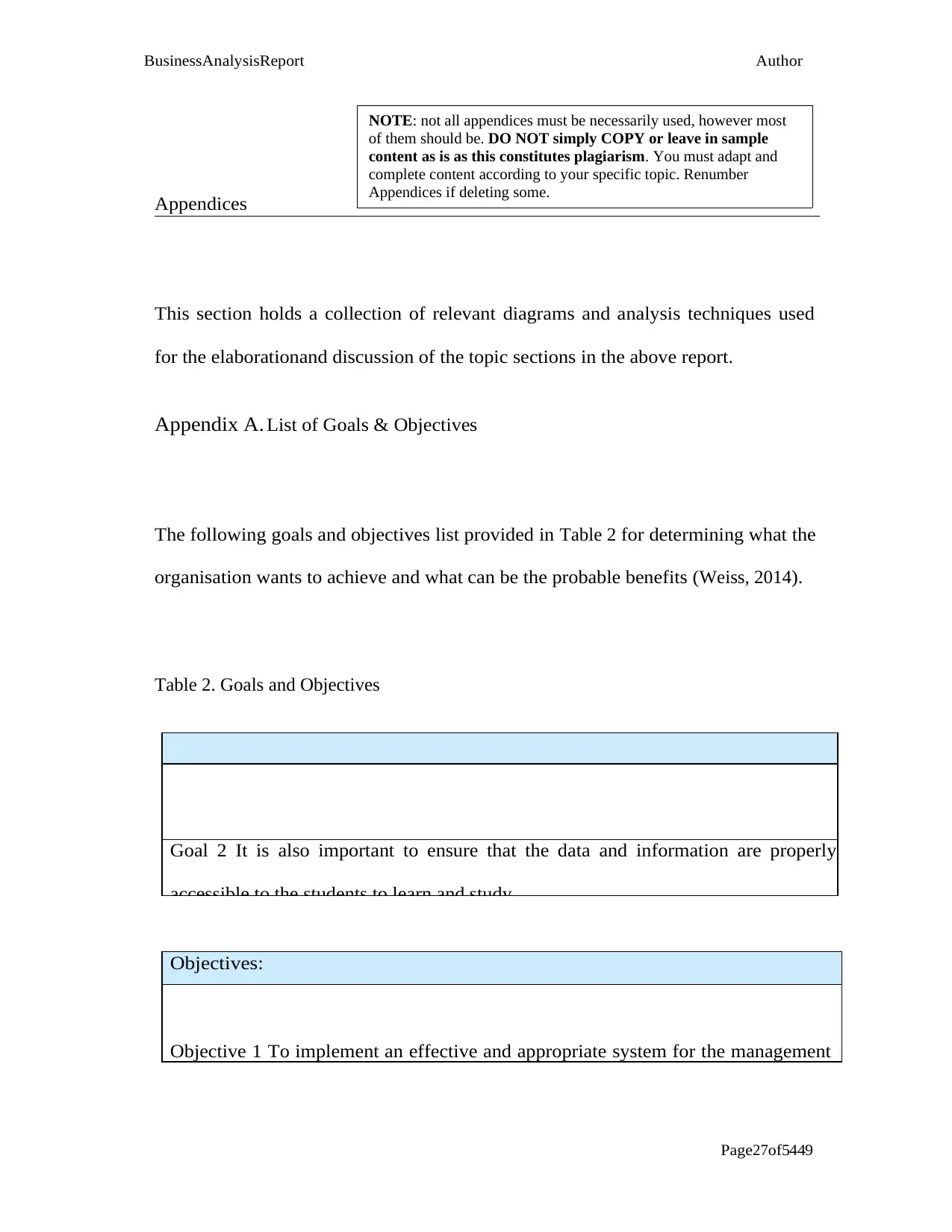
BusinessAnalysisReport Author
Page27of5449
Appendices
This section holds a collection of relevant diagrams and analysis techniques used
for the elaborationand discussion of the topic sections in the above report.
Appendix A. List of Goals & Objectives
The following goals and objectives list provided in Table 2 for determining what the
organisation wants to achieve and what can be the probable benefits (Weiss, 2014 ).
Table 2. Goals and Objectives
Goal 2 It is also important to ensure that the data and information are properly
accessible to the students to learn and study
Objectives:
Objective 1 To implement an effective and appropriate system for the management
NOTE: not all appendices must be necessarily used, however most
of them should be. DO NOT simply COPY or leave in sample
content as is as this constitutes plagiarism. You must adapt and
complete content according to your specific topic. Renumber
Appendices if deleting some.
Page27of5449
Appendices
This section holds a collection of relevant diagrams and analysis techniques used
for the elaborationand discussion of the topic sections in the above report.
Appendix A. List of Goals & Objectives
The following goals and objectives list provided in Table 2 for determining what the
organisation wants to achieve and what can be the probable benefits (Weiss, 2014 ).
Table 2. Goals and Objectives
Goal 2 It is also important to ensure that the data and information are properly
accessible to the students to learn and study
Objectives:
Objective 1 To implement an effective and appropriate system for the management
NOTE: not all appendices must be necessarily used, however most
of them should be. DO NOT simply COPY or leave in sample
content as is as this constitutes plagiarism. You must adapt and
complete content according to your specific topic. Renumber
Appendices if deleting some.

BusinessAnalysisReport Author
Page28of5449
Objective 2 With the help of Human Activity system, assess the various activities
of human beings to provide better flexibility to the students and furthermore help
Appendix B. SMART Analysis
A SMART analysis was conducted to assess each specific objective and whether
they were detailed in how they were to be achieved.
Table 3. SMART Analysis
Objective: Objective 1
Specific The specific issue is to reduce the chances of risks or issues
associated with the Human Activity system for learning
Measurable To improve the efficiency of the organisation to attract new
students as well as retain the existing ones by meeting the student
Achievable To implement an effective Information technology system
for developing online learning portal for students as well
Relevant To manage the learning procedures properly with the
appointment of faculties and academicians who have the right
Time Bounded To enhance the faculty services to the University within less
time and monitor the activities of students to identify the areas
where they lacked expertise and then deliver proper learning
Appendix C. SWOT Analysis
Page28of5449
Objective 2 With the help of Human Activity system, assess the various activities
of human beings to provide better flexibility to the students and furthermore help
Appendix B. SMART Analysis
A SMART analysis was conducted to assess each specific objective and whether
they were detailed in how they were to be achieved.
Table 3. SMART Analysis
Objective: Objective 1
Specific The specific issue is to reduce the chances of risks or issues
associated with the Human Activity system for learning
Measurable To improve the efficiency of the organisation to attract new
students as well as retain the existing ones by meeting the student
Achievable To implement an effective Information technology system
for developing online learning portal for students as well
Relevant To manage the learning procedures properly with the
appointment of faculties and academicians who have the right
Time Bounded To enhance the faculty services to the University within less
time and monitor the activities of students to identify the areas
where they lacked expertise and then deliver proper learning
Appendix C. SWOT Analysis
Paraphrase This Document
Need a fresh take? Get an instant paraphrase of this document with our AI Paraphraser
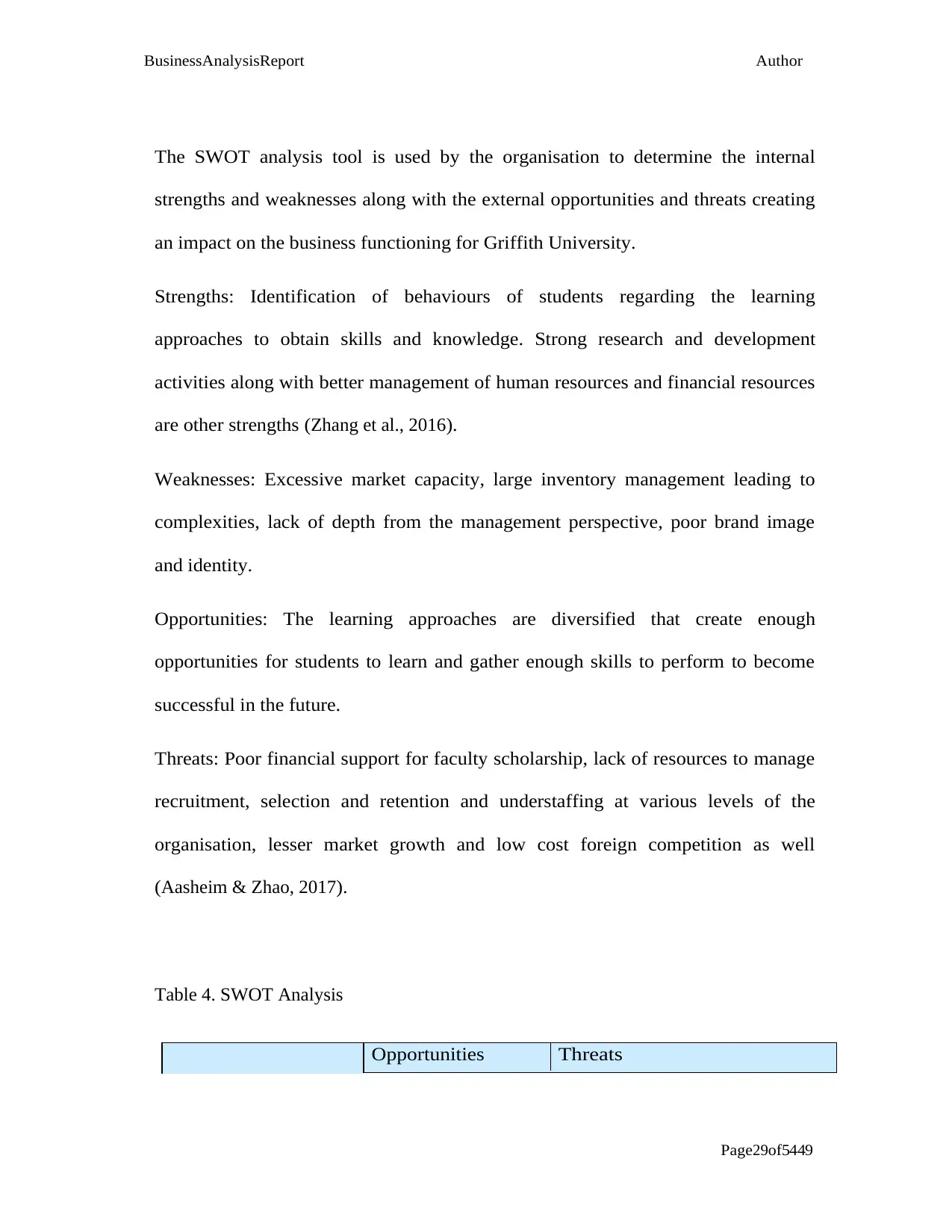
BusinessAnalysisReport Author
Page29of5449
The SWOT analysis tool is used by the organisation to determine the internal
strengths and weaknesses along with the external opportunities and threats creating
an impact on the business functioning for Griffith University.
Strengths: Identification of behaviours of students regarding the learning
approaches to obtain skills and knowledge. Strong research and development
activities along with better management of human resources and financial resources
are other strengths (Zhang et al., 2016 ).
Weaknesses: Excessive market capacity, large inventory management leading to
complexities, lack of depth from the management perspective, poor brand image
and identity.
Opportunities: The learning approaches are diversified that create enough
opportunities for students to learn and gather enough skills to perform to become
successful in the future.
Threats: Poor financial support for faculty scholarship, lack of resources to manage
recruitment, selection and retention and understaffing at various levels of the
organisation, lesser market growth and low cost foreign competition as well
(Aasheim & Zhao, 2017 ).
Table 4. SWOT Analysis
Opportunities Threats
Page29of5449
The SWOT analysis tool is used by the organisation to determine the internal
strengths and weaknesses along with the external opportunities and threats creating
an impact on the business functioning for Griffith University.
Strengths: Identification of behaviours of students regarding the learning
approaches to obtain skills and knowledge. Strong research and development
activities along with better management of human resources and financial resources
are other strengths (Zhang et al., 2016 ).
Weaknesses: Excessive market capacity, large inventory management leading to
complexities, lack of depth from the management perspective, poor brand image
and identity.
Opportunities: The learning approaches are diversified that create enough
opportunities for students to learn and gather enough skills to perform to become
successful in the future.
Threats: Poor financial support for faculty scholarship, lack of resources to manage
recruitment, selection and retention and understaffing at various levels of the
organisation, lesser market growth and low cost foreign competition as well
(Aasheim & Zhao, 2017 ).
Table 4. SWOT Analysis
Opportunities Threats

BusinessAnalysisReport Author
Page30of5449
Strengths SO Strategies:
Learning
management
ST Strategies:
String brand name and positive
image
Weaknesses WO Strategies:
Retain the existing
students
WT Strategies:
Enhance the course offerings and
reduce threats of losing students
Appendix D. The 5 Whys
Table 5. Five Whys Technique applied to Problem 1, 2, 3 (for example)
Enrolment issues Time issues Data accessibility issues
Why? Lack of flexibility of
course options
Why is the problem
happening?
Lack of access to data and
information
Why? Lack of engagement
and retention of
students
Incompletion of course Issues related to
learning management
Why? Limited options for
completion of a
Shorter time period
for courses
IT issues
Why? Lower enrolment
rate
Attracting and
retention at a lower
Lack of resources
Why? Absence of course
availability
Poor human
resource
Not gaining access to
proper data and
Appendix E. Key Stakeholders’ Role, Authority, Interest and Influence
Page30of5449
Strengths SO Strategies:
Learning
management
ST Strategies:
String brand name and positive
image
Weaknesses WO Strategies:
Retain the existing
students
WT Strategies:
Enhance the course offerings and
reduce threats of losing students
Appendix D. The 5 Whys
Table 5. Five Whys Technique applied to Problem 1, 2, 3 (for example)
Enrolment issues Time issues Data accessibility issues
Why? Lack of flexibility of
course options
Why is the problem
happening?
Lack of access to data and
information
Why? Lack of engagement
and retention of
students
Incompletion of course Issues related to
learning management
Why? Limited options for
completion of a
Shorter time period
for courses
IT issues
Why? Lower enrolment
rate
Attracting and
retention at a lower
Lack of resources
Why? Absence of course
availability
Poor human
resource
Not gaining access to
proper data and
Appendix E. Key Stakeholders’ Role, Authority, Interest and Influence

BusinessAnalysisReport Author
Page31of5449
Table 6. Key Stakeholder List with Roles, Authority, Interest and Influence
Stakeholder
Group
Role Impact influence Category Authority
Faculties Teach the students
registered in various
courses
High Medium Internal
Stakeholder
High
Lecturers Provide lecture on the
subject in hand
Low Low Internal
Stakeholder
Low
Administrator
of Students
Oversees the
administration work
High Medium Internal
Stakeholder
medium
Career
Management
Advisor
Guide the students in
their career with respect
to their chosen stream
Medium Medium Internal
Stakeholder
Low
Government of
Australia
Support the University
with necessary funding
High Medium External
Stakeholder
High
Director of
Planning
Prepare and look after
the strategic
management in the
University
High High Internal
Stakeholder
High
Page31of5449
Table 6. Key Stakeholder List with Roles, Authority, Interest and Influence
Stakeholder
Group
Role Impact influence Category Authority
Faculties Teach the students
registered in various
courses
High Medium Internal
Stakeholder
High
Lecturers Provide lecture on the
subject in hand
Low Low Internal
Stakeholder
Low
Administrator
of Students
Oversees the
administration work
High Medium Internal
Stakeholder
medium
Career
Management
Advisor
Guide the students in
their career with respect
to their chosen stream
Medium Medium Internal
Stakeholder
Low
Government of
Australia
Support the University
with necessary funding
High Medium External
Stakeholder
High
Director of
Planning
Prepare and look after
the strategic
management in the
University
High High Internal
Stakeholder
High
Secure Best Marks with AI Grader
Need help grading? Try our AI Grader for instant feedback on your assignments.
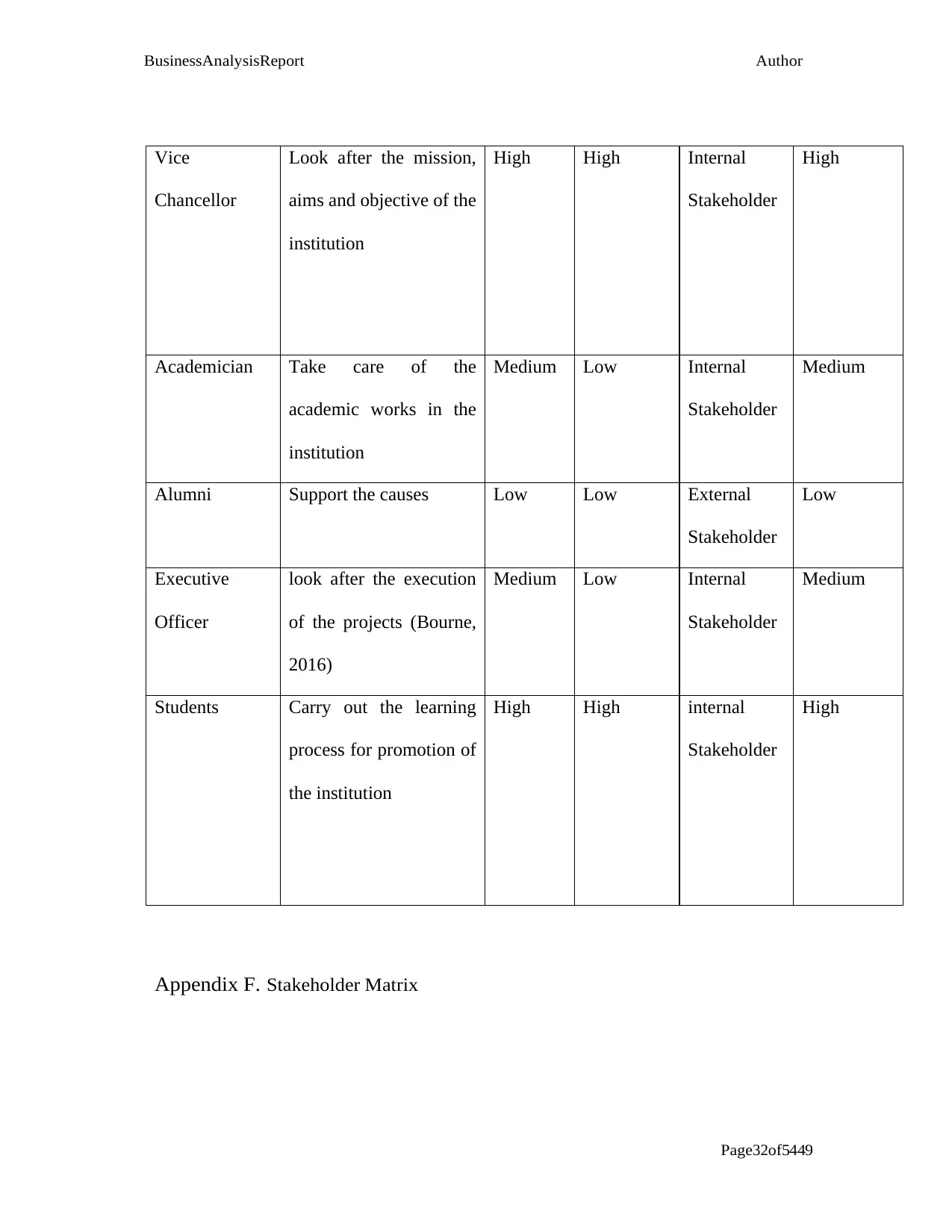
BusinessAnalysisReport Author
Page32of5449
Vice
Chancellor
Look after the mission,
aims and objective of the
institution
High High Internal
Stakeholder
High
Academician Take care of the
academic works in the
institution
Medium Low Internal
Stakeholder
Medium
Alumni Support the causes Low Low External
Stakeholder
Low
Executive
Officer
look after the execution
of the projects (Bourne,
2016)
Medium Low Internal
Stakeholder
Medium
Students Carry out the learning
process for promotion of
the institution
High High internal
Stakeholder
High
Appendix F. Stakeholder Matrix
Page32of5449
Vice
Chancellor
Look after the mission,
aims and objective of the
institution
High High Internal
Stakeholder
High
Academician Take care of the
academic works in the
institution
Medium Low Internal
Stakeholder
Medium
Alumni Support the causes Low Low External
Stakeholder
Low
Executive
Officer
look after the execution
of the projects (Bourne,
2016)
Medium Low Internal
Stakeholder
Medium
Students Carry out the learning
process for promotion of
the institution
High High internal
Stakeholder
High
Appendix F. Stakeholder Matrix
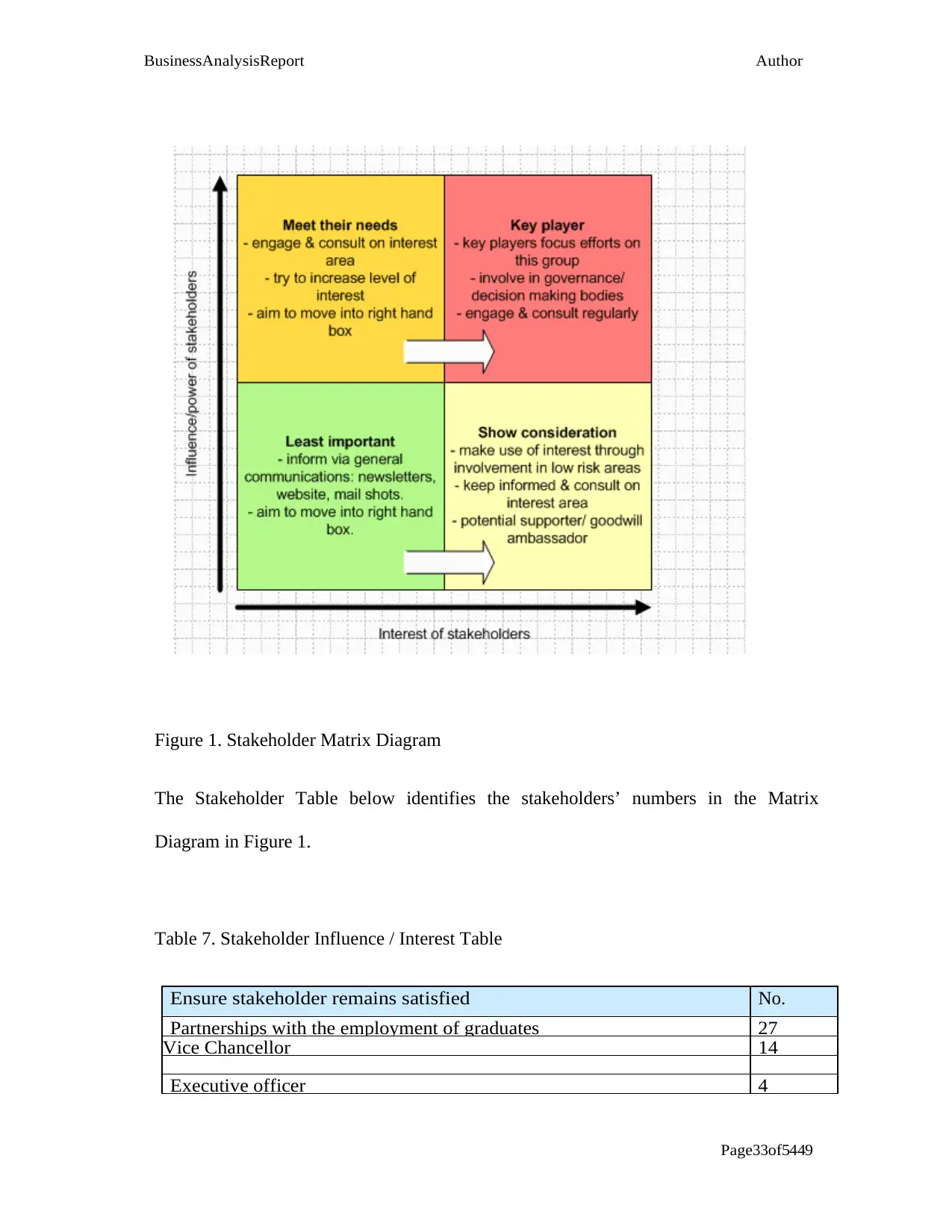
BusinessAnalysisReport Author
Page33of5449
Figure 1. Stakeholder Matrix Diagram
The Stakeholder Table below identifies the stakeholders’ numbers in the Matrix
Diagram in Figure 1.
Table 7. Stakeholder Influence / Interest Table
Ensure stakeholder remains satisfied No.
Partnerships with the employment of graduates 27
Vice Chancellor 14
Executive officer 4
Page33of5449
Figure 1. Stakeholder Matrix Diagram
The Stakeholder Table below identifies the stakeholders’ numbers in the Matrix
Diagram in Figure 1.
Table 7. Stakeholder Influence / Interest Table
Ensure stakeholder remains satisfied No.
Partnerships with the employment of graduates 27
Vice Chancellor 14
Executive officer 4

BusinessAnalysisReport Author
Page34of5449
Lecturer 3
Team undergoing the research and development activities 21
Director of planning 19
Chancellor 18
Vice Chancellor 17
Administrator 26
Lecturers 25
Academicians 22
Director of planning of courses 16
Various Australian universities 29
Government of Australia 28
Management departments 20
Appendix G. Onion Diagram
The onion diagram represents a chart consisting of the dependencies among the
various organisational functions and processes that are managed. The items have
been displayed within the concentric circle and the items are dependent upon the
items that have been present in the smaller rings. Here the internal stakeholders
are present within the inner circle along with their level of authority and they are
dependent upon the external stakeholders who are also presented based on their
degree and level of authorities.
Page34of5449
Lecturer 3
Team undergoing the research and development activities 21
Director of planning 19
Chancellor 18
Vice Chancellor 17
Administrator 26
Lecturers 25
Academicians 22
Director of planning of courses 16
Various Australian universities 29
Government of Australia 28
Management departments 20
Appendix G. Onion Diagram
The onion diagram represents a chart consisting of the dependencies among the
various organisational functions and processes that are managed. The items have
been displayed within the concentric circle and the items are dependent upon the
items that have been present in the smaller rings. Here the internal stakeholders
are present within the inner circle along with their level of authority and they are
dependent upon the external stakeholders who are also presented based on their
degree and level of authorities.
Paraphrase This Document
Need a fresh take? Get an instant paraphrase of this document with our AI Paraphraser

BusinessAnalysisReport Author
Page35of5449
Figure 2: Onion Diagram
The Stakeholder Table below identifies the stakeholders’ numbers in the Matrix
Diagram in Figure 2.
Table 8. Onion Diagram Legend
Affected External Stakeholders No.
Government of Australia 5
Alumni 11
Internal Stakeholders No.
Page35of5449
Figure 2: Onion Diagram
The Stakeholder Table below identifies the stakeholders’ numbers in the Matrix
Diagram in Figure 2.
Table 8. Onion Diagram Legend
Affected External Stakeholders No.
Government of Australia 5
Alumni 11
Internal Stakeholders No.

BusinessAnalysisReport Author
Page36of5449
Faculties 1
Lecturers 9
Administrators of Students 7
Career Management Advisor 10
Director of Planning 2
Vice Chancellor 3
Academician 8
Executive officer
Student 4
Page36of5449
Faculties 1
Lecturers 9
Administrators of Students 7
Career Management Advisor 10
Director of Planning 2
Vice Chancellor 3
Academician 8
Executive officer
Student 4

BusinessAnalysisReport Author
Page37of5449
Appendix H. RACI Matrix
The RACI matrix shows the linear responsibility and participation of the various
roles of individuals during the completion of tasks within the Griffith University.
As it could be seen from the table, faculties, lecturers, Australian Government are
considered as informed who inform various information and messages related to the
issues of human activity system for learning management. The planning director
and vice chancellor have been held as responsible while the administrator and
career advisor are regarded as consulted.
This technique is used to determine the level of authority and level of engagement.
Table 9. RACI Matrix
Change Request Process RACI
Faculties I
Lecturers I
Administrator of Students C
Career Management Advisor C
Government of Australia I
Director of Planning R
Vice Chancellor R
Page37of5449
Appendix H. RACI Matrix
The RACI matrix shows the linear responsibility and participation of the various
roles of individuals during the completion of tasks within the Griffith University.
As it could be seen from the table, faculties, lecturers, Australian Government are
considered as informed who inform various information and messages related to the
issues of human activity system for learning management. The planning director
and vice chancellor have been held as responsible while the administrator and
career advisor are regarded as consulted.
This technique is used to determine the level of authority and level of engagement.
Table 9. RACI Matrix
Change Request Process RACI
Faculties I
Lecturers I
Administrator of Students C
Career Management Advisor C
Government of Australia I
Director of Planning R
Vice Chancellor R
Secure Best Marks with AI Grader
Need help grading? Try our AI Grader for instant feedback on your assignments.
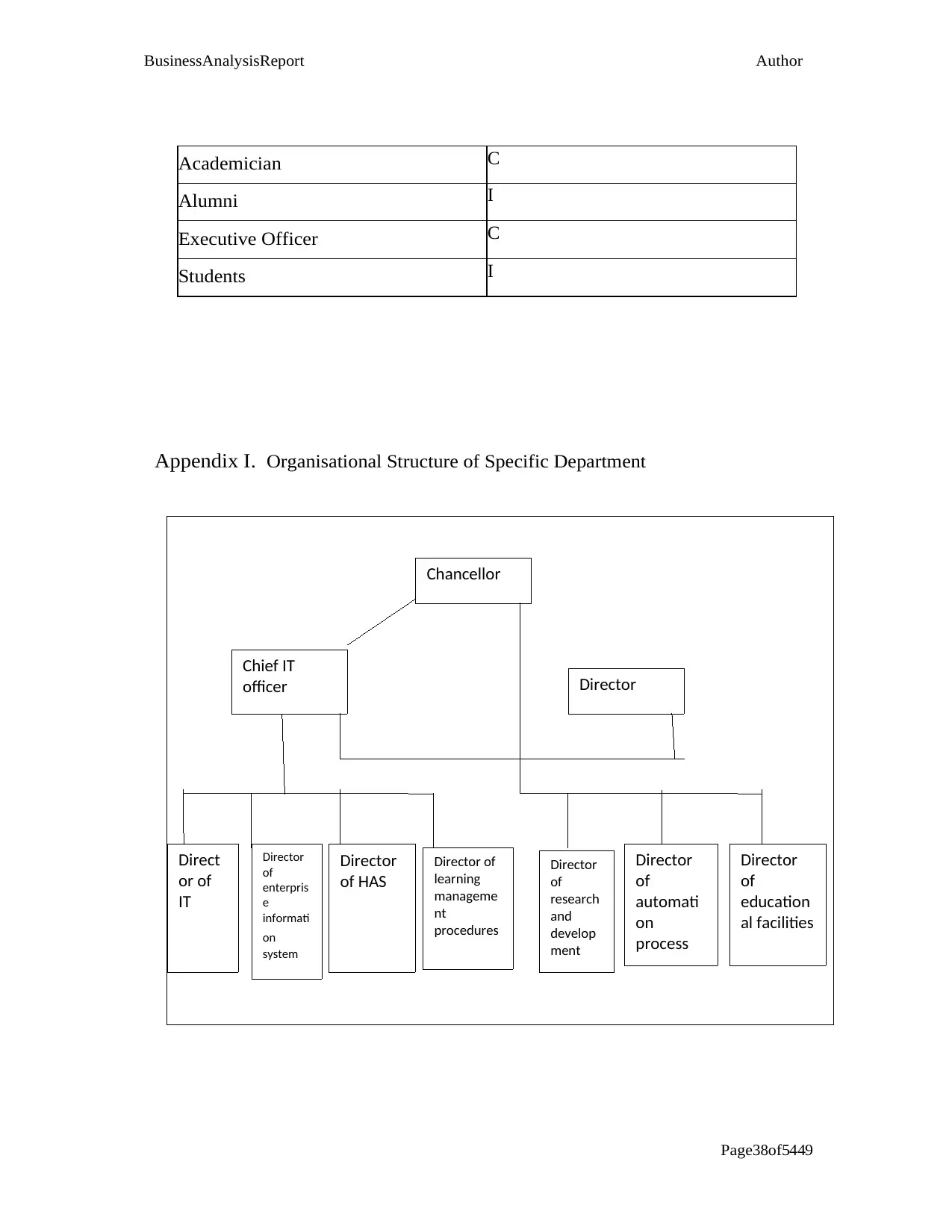
BusinessAnalysisReport Author
Page38of5449
Academician C
Alumni I
Executive Officer C
Students I
Appendix I. Organisational Structure of Specific Department
Chancellor
Director
Chief IT
officer
Director
of
education
al facilities
Director
of
automati
on
process
Director
of
research
and
develop
ment
Director of
learning
manageme
nt
procedures
Director
of HAS
Director
of
enterpris
e
informati
on
system
Direct
or of
IT
Page38of5449
Academician C
Alumni I
Executive Officer C
Students I
Appendix I. Organisational Structure of Specific Department
Chancellor
Director
Chief IT
officer
Director
of
education
al facilities
Director
of
automati
on
process
Director
of
research
and
develop
ment
Director of
learning
manageme
nt
procedures
Director
of HAS
Director
of
enterpris
e
informati
on
system
Direct
or of
IT

BusinessAnalysisReport Author
Page39of5449
Figure 3. Department Organisational Structure
Appendix J. N/A
Spare
Appendix K. The Five Conflict Handling Modes
The Conflict Handling mode chosen to manage communication between
stakeholders and manage competence, collaboration of work, compromise, avoid
and accommodate necessary changes to improve the learning approaches
management within Griffith University. The Five Conflict Handling Mode is used
to manage communication between the stakeholders and minimize the chances of
conflict in the organization (Bratton & Gold, 2012 ). This mode is used to ensure the
agreement between the stakeholders and keep them in the single level of
communication. It facilitates in minimizing the diversified views of the stakeholder
that result into conflict (Bourne, 2016 ).
Page39of5449
Figure 3. Department Organisational Structure
Appendix J. N/A
Spare
Appendix K. The Five Conflict Handling Modes
The Conflict Handling mode chosen to manage communication between
stakeholders and manage competence, collaboration of work, compromise, avoid
and accommodate necessary changes to improve the learning approaches
management within Griffith University. The Five Conflict Handling Mode is used
to manage communication between the stakeholders and minimize the chances of
conflict in the organization (Bratton & Gold, 2012 ). This mode is used to ensure the
agreement between the stakeholders and keep them in the single level of
communication. It facilitates in minimizing the diversified views of the stakeholder
that result into conflict (Bourne, 2016 ).
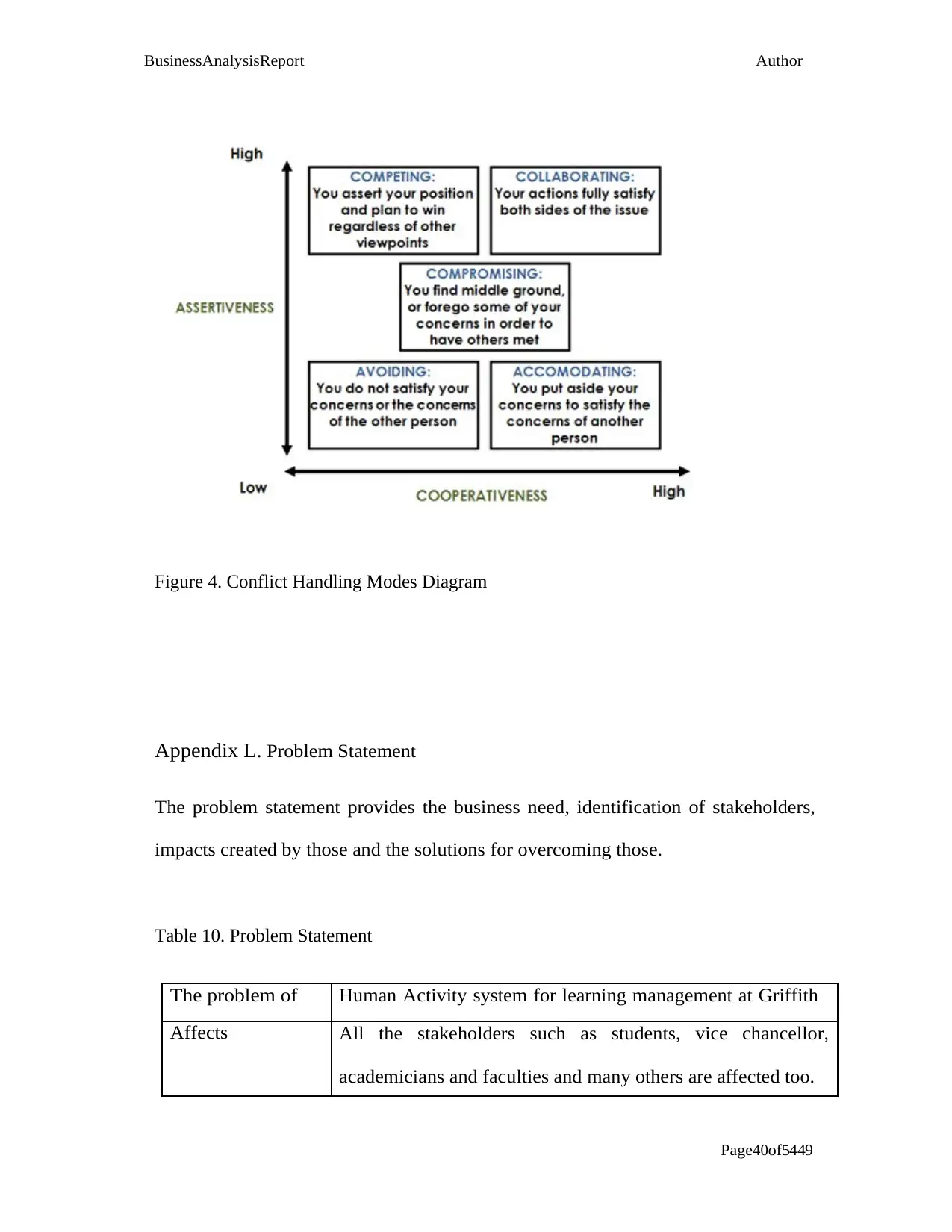
BusinessAnalysisReport Author
Page40of5449
Figure 4. Conflict Handling Modes Diagram
Appendix L. Problem Statement
The problem statement provides the business need, identification of stakeholders,
impacts created by those and the solutions for overcoming those.
Table 10. Problem Statement
The problem of Human Activity system for learning management at Griffith
UniversityAffects All the stakeholders such as students, vice chancellor,
academicians and faculties and many others are affected too.
Page40of5449
Figure 4. Conflict Handling Modes Diagram
Appendix L. Problem Statement
The problem statement provides the business need, identification of stakeholders,
impacts created by those and the solutions for overcoming those.
Table 10. Problem Statement
The problem of Human Activity system for learning management at Griffith
UniversityAffects All the stakeholders such as students, vice chancellor,
academicians and faculties and many others are affected too.
Paraphrase This Document
Need a fresh take? Get an instant paraphrase of this document with our AI Paraphraser

BusinessAnalysisReport Author
Page41of5449
The impact
of which is
Lack of accessibility to important data and information,
increased turnover and lesser enrolment of students (Bull et
al., 2016).A successful
solution
would
Improve the management of learning approaches and
ensure that right amounts of data and information are
available for allowing the students to learn and enhance
Appendix M. Force Field Analysis
The Force field analysis helps in development of social science for identifying the
factors influencing a certain situation happened during the time when issues of HAS
were experienced while using learning management procedures.
Strength of force Forces influencing change Opposing force Strength
4 4
6 2
8 3
Total = 18 Total = 9
Better flexibility
Utilization of
resources properly
Better enrollment
procedures
Lack of teaching for
completion of course
Poor
infrastructure
development
Limitations to meet
the enrolment
criteria
Human
Activity
system for
learning
management
Page41of5449
The impact
of which is
Lack of accessibility to important data and information,
increased turnover and lesser enrolment of students (Bull et
al., 2016).A successful
solution
would
Improve the management of learning approaches and
ensure that right amounts of data and information are
available for allowing the students to learn and enhance
Appendix M. Force Field Analysis
The Force field analysis helps in development of social science for identifying the
factors influencing a certain situation happened during the time when issues of HAS
were experienced while using learning management procedures.
Strength of force Forces influencing change Opposing force Strength
4 4
6 2
8 3
Total = 18 Total = 9
Better flexibility
Utilization of
resources properly
Better enrollment
procedures
Lack of teaching for
completion of course
Poor
infrastructure
development
Limitations to meet
the enrolment
criteria
Human
Activity
system for
learning
management
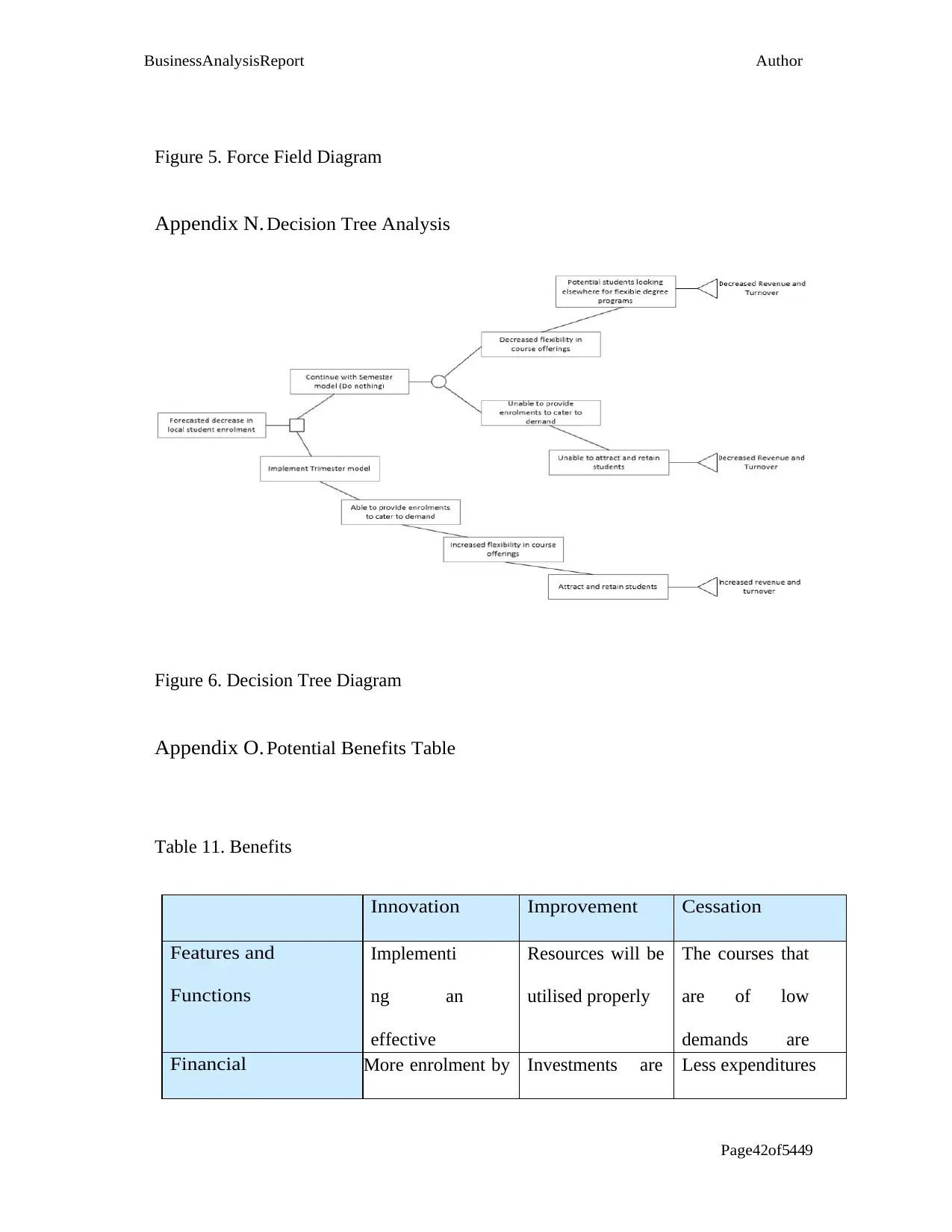
BusinessAnalysisReport Author
Page42of5449
Figure 5. Force Field Diagram
Appendix N. Decision Tree Analysis
Figure 6. Decision Tree Diagram
Appendix O. Potential Benefits Table
Table 11. Benefits
Innovation Improvement Cessation
Features and
Functions
Implementi
ng an
effective
Human
Resources will be
utilised properly
The courses that
are of low
demands are
stopped
Financial More enrolment by Investments are Less expenditures
Page42of5449
Figure 5. Force Field Diagram
Appendix N. Decision Tree Analysis
Figure 6. Decision Tree Diagram
Appendix O. Potential Benefits Table
Table 11. Benefits
Innovation Improvement Cessation
Features and
Functions
Implementi
ng an
effective
Human
Resources will be
utilised properly
The courses that
are of low
demands are
stopped
Financial More enrolment by Investments are Less expenditures
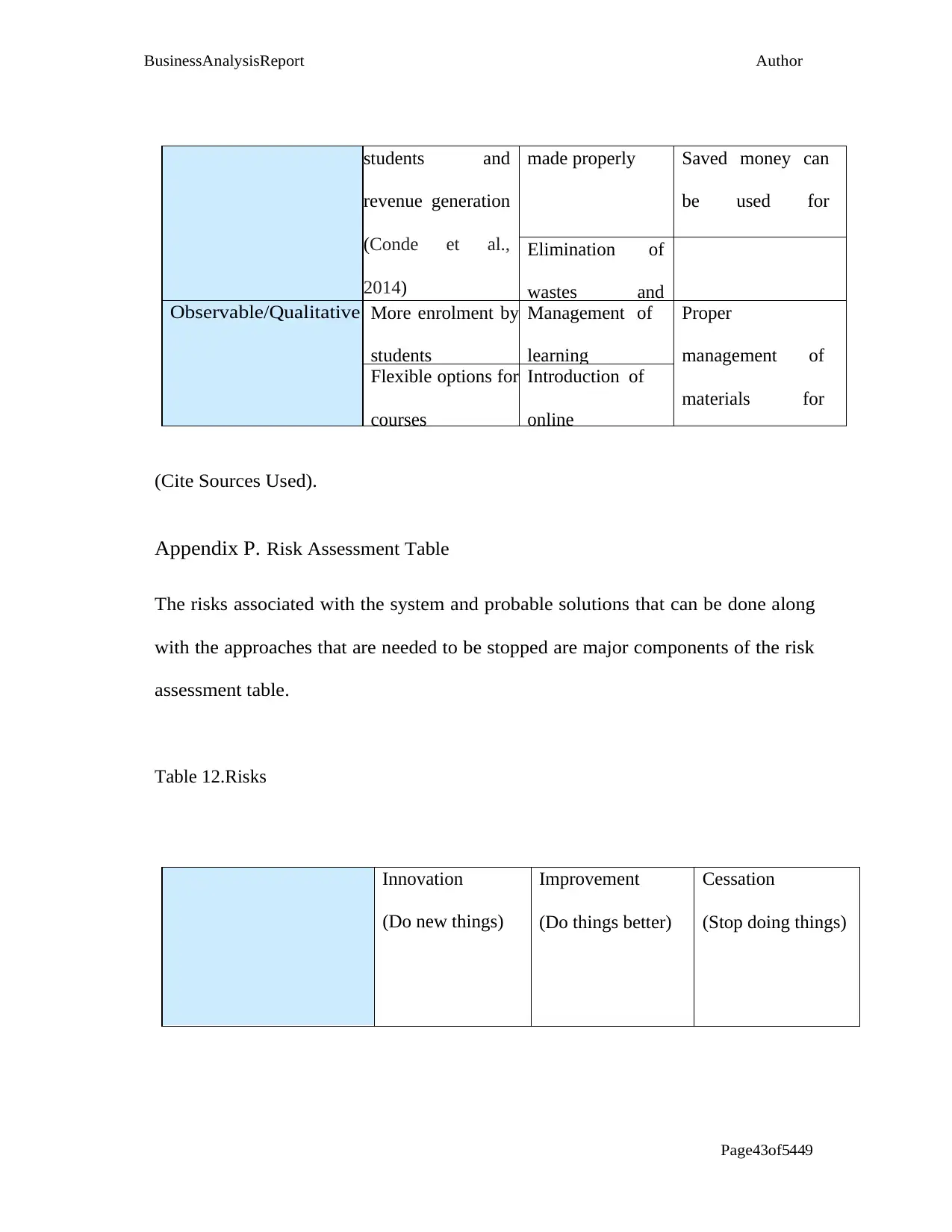
BusinessAnalysisReport Author
Page43of5449
students and
revenue generation
(Conde et al.,
2014)
made properly Saved money can
be used for
installation of newElimination of
wastes and
Observable/Qualitative More enrolment by
students
Management of
learning
Proper
management of
materials for
successful course
Flexible options for
courses
Introduction of
online
(Cite Sources Used).
Appendix P. Risk Assessment Table
The risks associated with the system and probable solutions that can be done along
with the approaches that are needed to be stopped are major components of the risk
assessment table.
Table 12.Risks
Innovation
(Do new things)
Improvement
(Do things better)
Cessation
(Stop doing things)
Page43of5449
students and
revenue generation
(Conde et al.,
2014)
made properly Saved money can
be used for
installation of newElimination of
wastes and
Observable/Qualitative More enrolment by
students
Management of
learning
Proper
management of
materials for
successful course
Flexible options for
courses
Introduction of
online
(Cite Sources Used).
Appendix P. Risk Assessment Table
The risks associated with the system and probable solutions that can be done along
with the approaches that are needed to be stopped are major components of the risk
assessment table.
Table 12.Risks
Innovation
(Do new things)
Improvement
(Do things better)
Cessation
(Stop doing things)
Secure Best Marks with AI Grader
Need help grading? Try our AI Grader for instant feedback on your assignments.

BusinessAnalysisReport Author
Page44of5449
Features and Functions Human activity
system for
learning
management
Resource
utilisation
Prevent lack of data
accessibility
Technical Poor
infarstrcuture
and IT system
Loss of data and
ifnromation
Unable to meet
the needs of
students
Financial Higher costs of
infrastructure
Higher
maintenance
cost
Stop wasting
money for
unnecessary study
materials
Investments by
shareholders
More expenses
Page44of5449
Features and Functions Human activity
system for
learning
management
Resource
utilisation
Prevent lack of data
accessibility
Technical Poor
infarstrcuture
and IT system
Loss of data and
ifnromation
Unable to meet
the needs of
students
Financial Higher costs of
infrastructure
Higher
maintenance
cost
Stop wasting
money for
unnecessary study
materials
Investments by
shareholders
More expenses
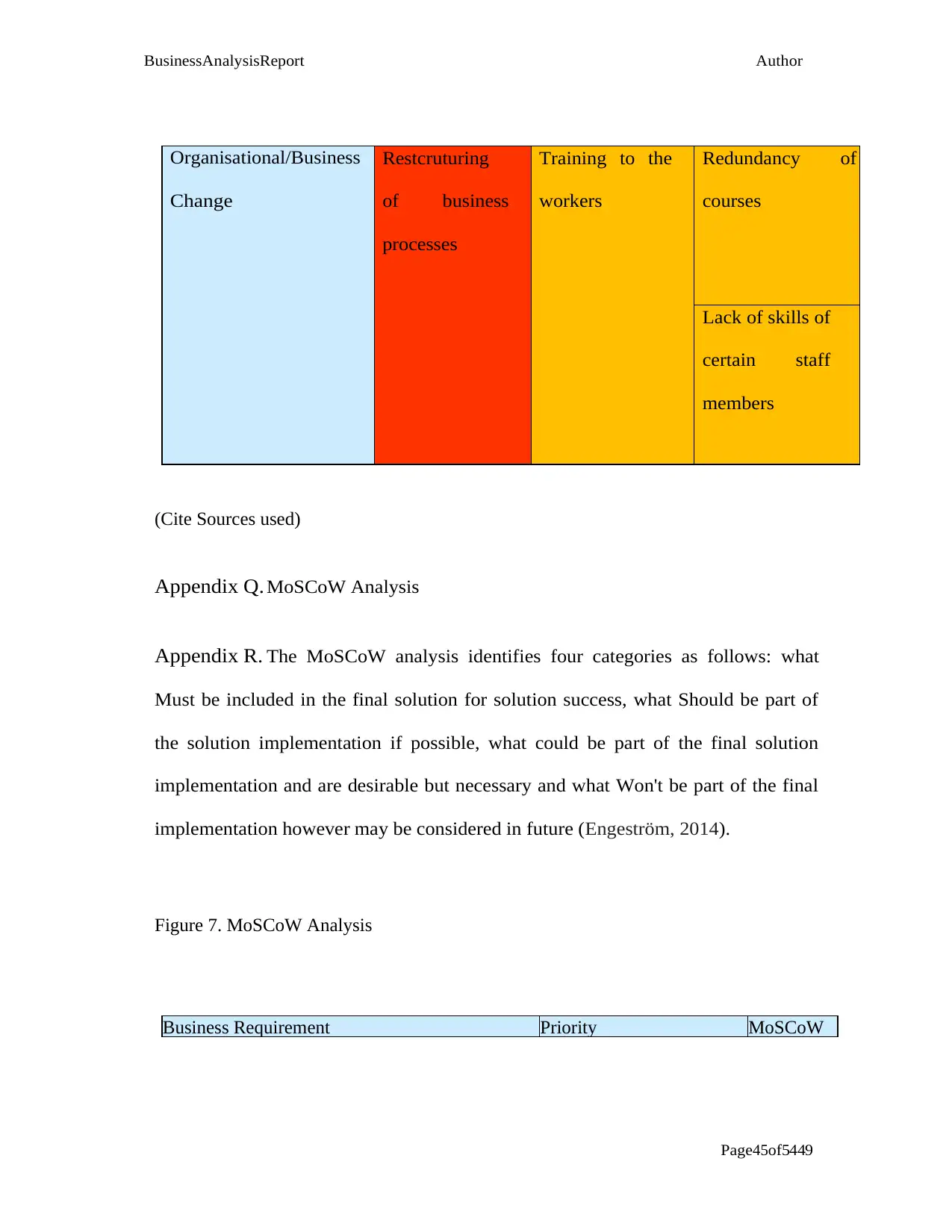
BusinessAnalysisReport Author
Page45of5449
Organisational/Business
Change
Restcruturing
of business
processes
Training to the
workers
Redundancy of
courses
Lack of skills of
certain staff
members
(Cite Sources used)
Appendix Q. MoSCoW Analysis
Appendix R. The MoSCoW analysis identifies four categories as follows: what
Must be included in the final solution for solution success, what Should be part of
the solution implementation if possible, what could be part of the final solution
implementation and are desirable but necessary and what Won't be part of the final
implementation however may be considered in future (Engeström, 2014).
Figure 7. MoSCoW Analysis
Business Requirement Priority MoSCoW
Page45of5449
Organisational/Business
Change
Restcruturing
of business
processes
Training to the
workers
Redundancy of
courses
Lack of skills of
certain staff
members
(Cite Sources used)
Appendix Q. MoSCoW Analysis
Appendix R. The MoSCoW analysis identifies four categories as follows: what
Must be included in the final solution for solution success, what Should be part of
the solution implementation if possible, what could be part of the final solution
implementation and are desirable but necessary and what Won't be part of the final
implementation however may be considered in future (Engeström, 2014).
Figure 7. MoSCoW Analysis
Business Requirement Priority MoSCoW
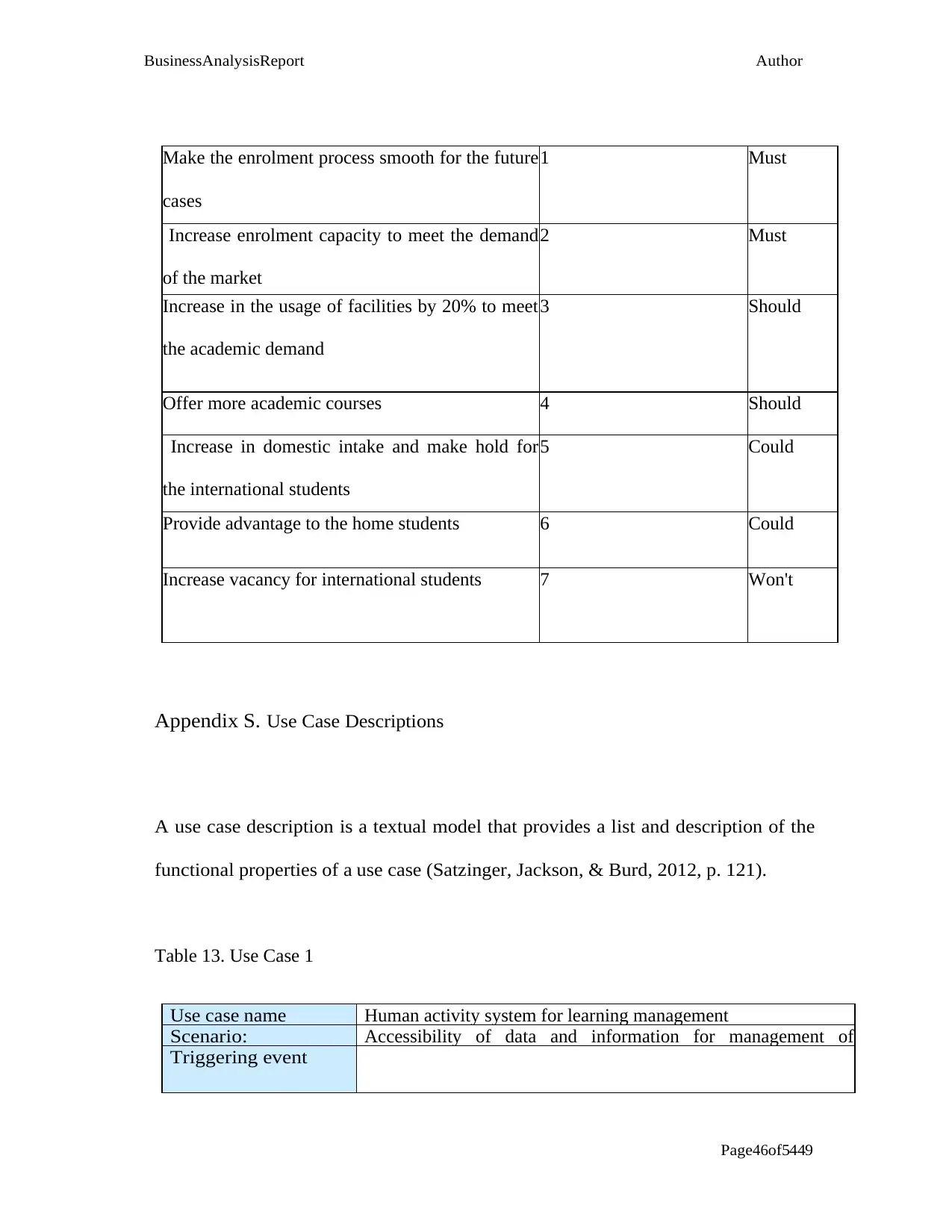
BusinessAnalysisReport Author
Page46of5449
Make the enrolment process smooth for the future
cases
1 Must
Increase enrolment capacity to meet the demand
of the market
2 Must
Increase in the usage of facilities by 20% to meet
the academic demand
3 Should
Offer more academic courses 4 Should
Increase in domestic intake and make hold for
the international students
5 Could
Provide advantage to the home students 6 Could
Increase vacancy for international students 7 Won't
Appendix S. Use Case Descriptions
A use case description is a textual model that provides a list and description of the
functional properties of a use case (Satzinger, Jackson, & Burd, 2012, p. 121).
Table 13. Use Case 1
Use case name Human activity system for learning management
Scenario: Accessibility of data and information for management of
Triggering event
Page46of5449
Make the enrolment process smooth for the future
cases
1 Must
Increase enrolment capacity to meet the demand
of the market
2 Must
Increase in the usage of facilities by 20% to meet
the academic demand
3 Should
Offer more academic courses 4 Should
Increase in domestic intake and make hold for
the international students
5 Could
Provide advantage to the home students 6 Could
Increase vacancy for international students 7 Won't
Appendix S. Use Case Descriptions
A use case description is a textual model that provides a list and description of the
functional properties of a use case (Satzinger, Jackson, & Burd, 2012, p. 121).
Table 13. Use Case 1
Use case name Human activity system for learning management
Scenario: Accessibility of data and information for management of
Triggering event
Paraphrase This Document
Need a fresh take? Get an instant paraphrase of this document with our AI Paraphraser

BusinessAnalysisReport Author
Page47of5449
Brief description The case study identified the issues with Human Activity
system for learning management at Griffith University
Actor/s: Students
Related use cases: Human activity system used for the learning management
within Griffith University
Stakeholders: Local students
International students
Academicians
Preconditions: Obtaining the student ID after enrolment is essential
Postconditions: - Time duration of course should be known to them
- Notifications regarding enrolment procedures
Flow of activities: Actor System
1. Individual user ID and
password for login to the
1.1 IT system to managing
portal
2. Searching though the
enrolments section to obtain
information about other
2.1 Courses and degree
programs available and
enrolled by the students
3. Select the course
units and learning
approaches that they
prefer
3.1 Confirmation messages
obtained after enrolment
Exception conditions: 2.1 No registered students
4.1 Classes not done for the individual learning course
(Griffith.edu.au, 2017 )
Appendix T. List of Non-Functional Requirements Analysis
Page47of5449
Brief description The case study identified the issues with Human Activity
system for learning management at Griffith University
Actor/s: Students
Related use cases: Human activity system used for the learning management
within Griffith University
Stakeholders: Local students
International students
Academicians
Preconditions: Obtaining the student ID after enrolment is essential
Postconditions: - Time duration of course should be known to them
- Notifications regarding enrolment procedures
Flow of activities: Actor System
1. Individual user ID and
password for login to the
1.1 IT system to managing
portal
2. Searching though the
enrolments section to obtain
information about other
2.1 Courses and degree
programs available and
enrolled by the students
3. Select the course
units and learning
approaches that they
prefer
3.1 Confirmation messages
obtained after enrolment
Exception conditions: 2.1 No registered students
4.1 Classes not done for the individual learning course
(Griffith.edu.au, 2017 )
Appendix T. List of Non-Functional Requirements Analysis

BusinessAnalysisReport Author
Page48of5449
Table 14. Non-functional Requirements
Category Non-functional Requirement
Reliability IT support must be utilized in its full potential
Performance
Efficiency
Online archive must be made available for each of their stakeholders
Operability The online webpage must be made customer friendly for all the
stakeholders especially from the students and teh faculties.
Security Access should be restricted to its internal stakeholders
Compatibility The page should be made compatible allowing the stakeholders to gain
access to the full course of the academic year at all time
Maintainability Software update should be done to maintain the efficiency without
disrupting the work flow.
Transferability Allow the stakeholders to access the system from any server with the user
ID and password
Page48of5449
Table 14. Non-functional Requirements
Category Non-functional Requirement
Reliability IT support must be utilized in its full potential
Performance
Efficiency
Online archive must be made available for each of their stakeholders
Operability The online webpage must be made customer friendly for all the
stakeholders especially from the students and teh faculties.
Security Access should be restricted to its internal stakeholders
Compatibility The page should be made compatible allowing the stakeholders to gain
access to the full course of the academic year at all time
Maintainability Software update should be done to maintain the efficiency without
disrupting the work flow.
Transferability Allow the stakeholders to access the system from any server with the user
ID and password
1 out of 51
Related Documents
Your All-in-One AI-Powered Toolkit for Academic Success.
+13062052269
info@desklib.com
Available 24*7 on WhatsApp / Email
![[object Object]](/_next/static/media/star-bottom.7253800d.svg)
Unlock your academic potential
© 2024 | Zucol Services PVT LTD | All rights reserved.





